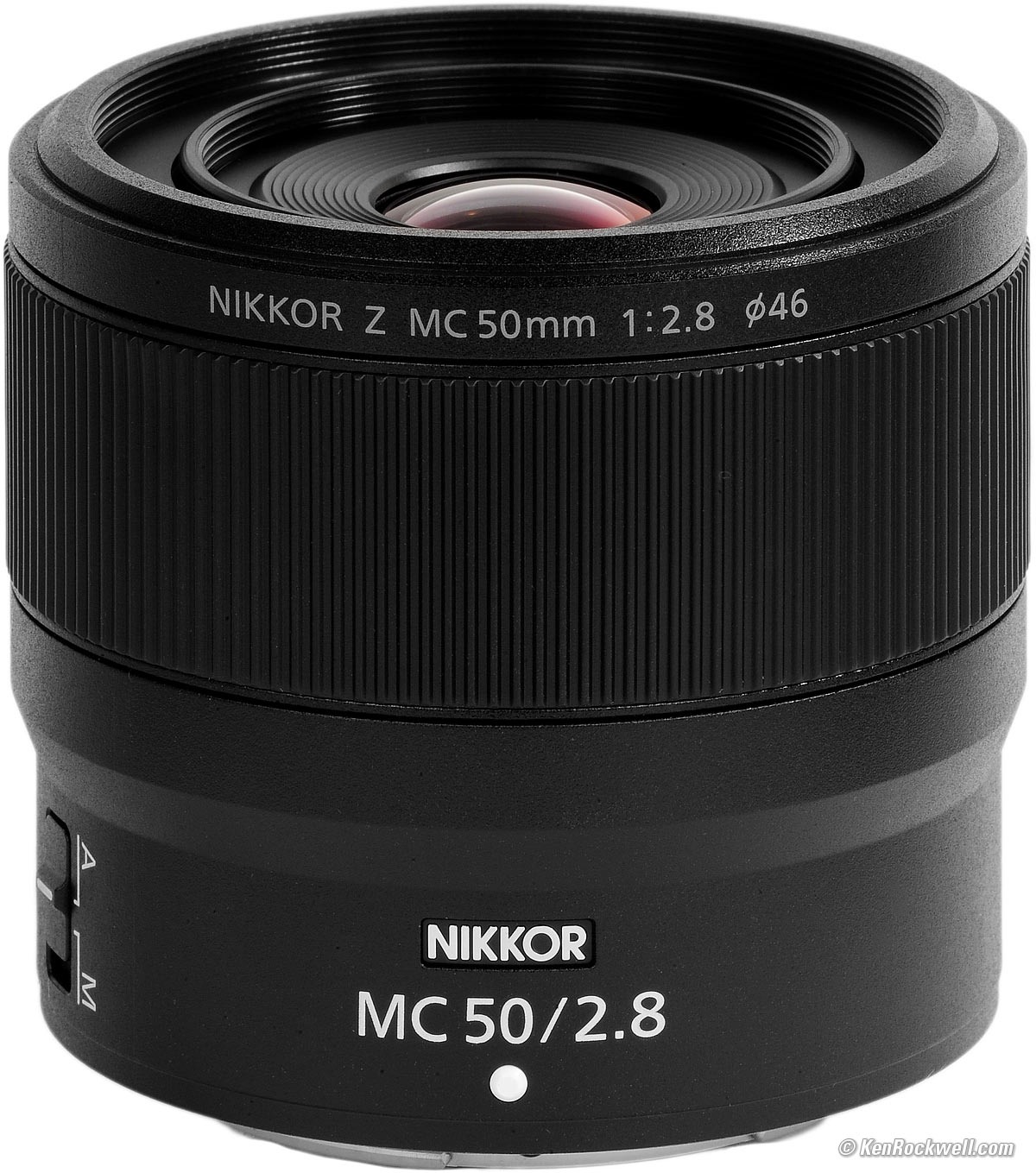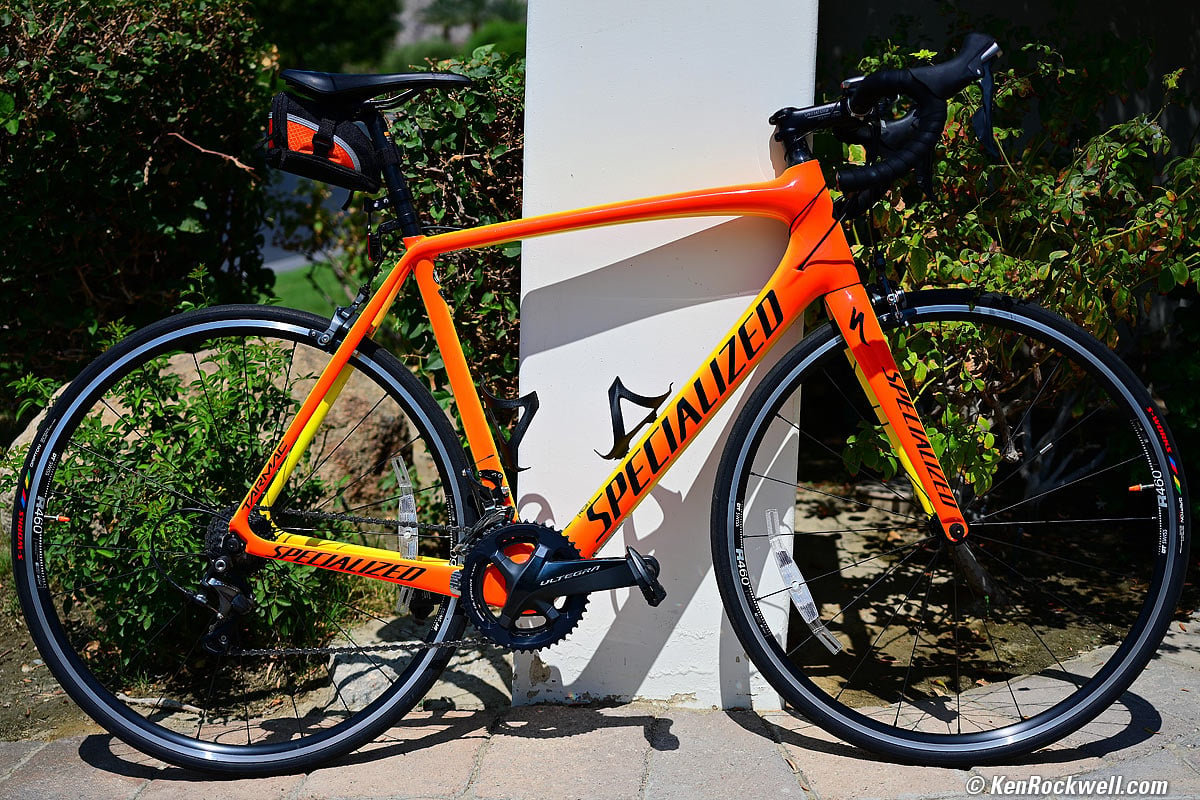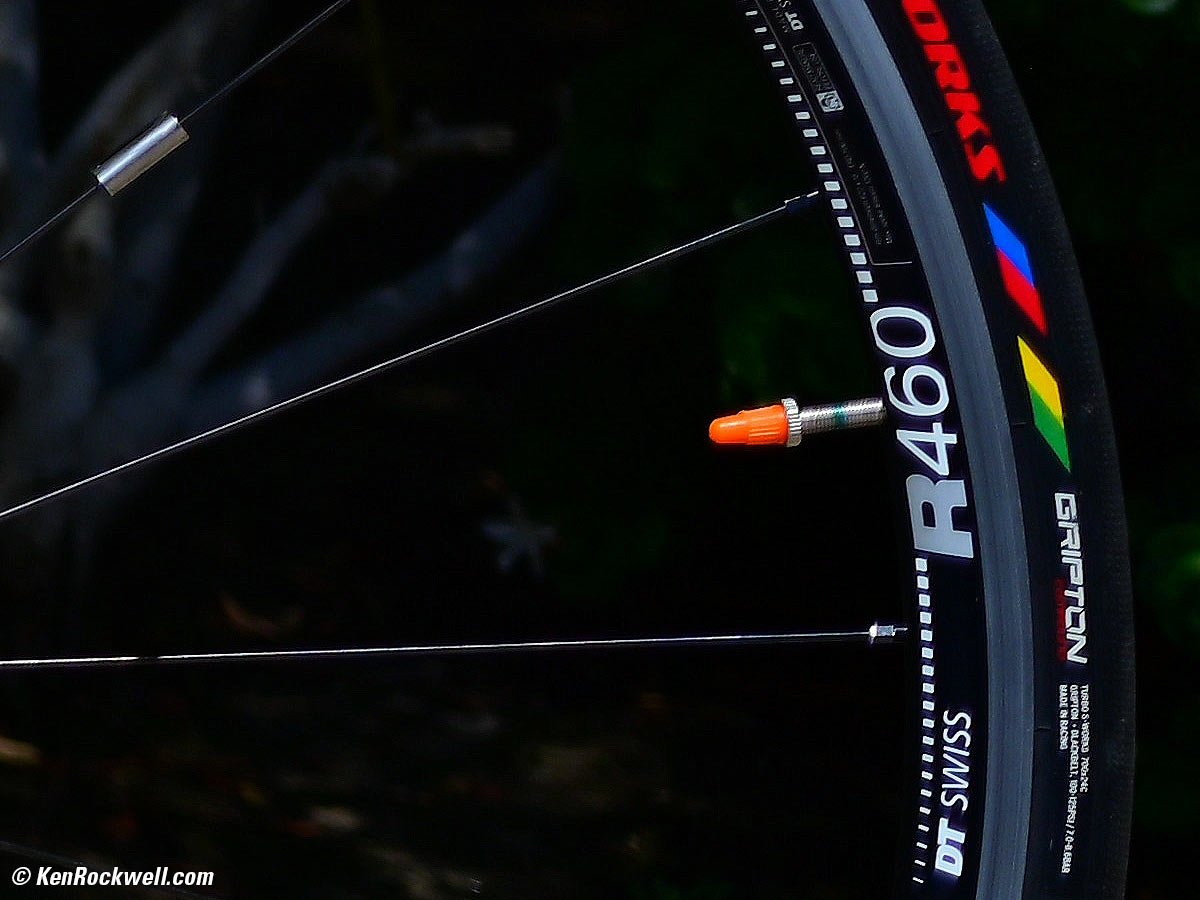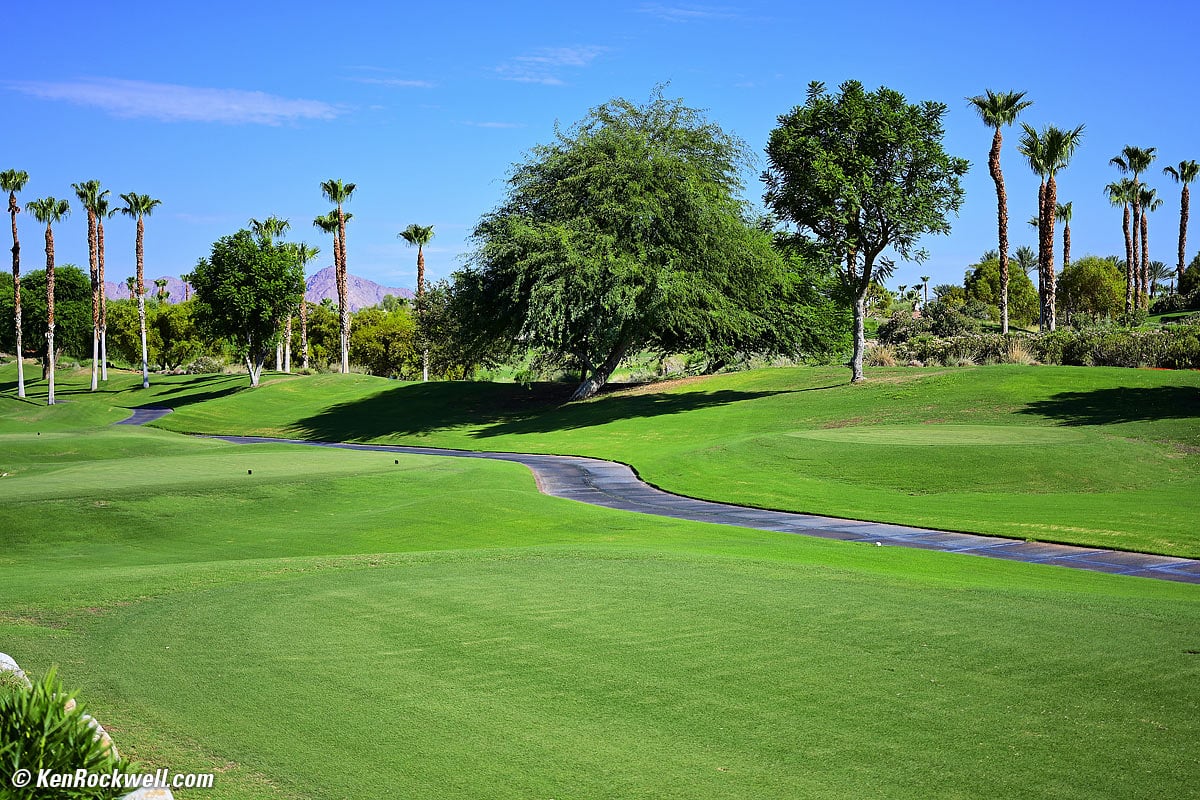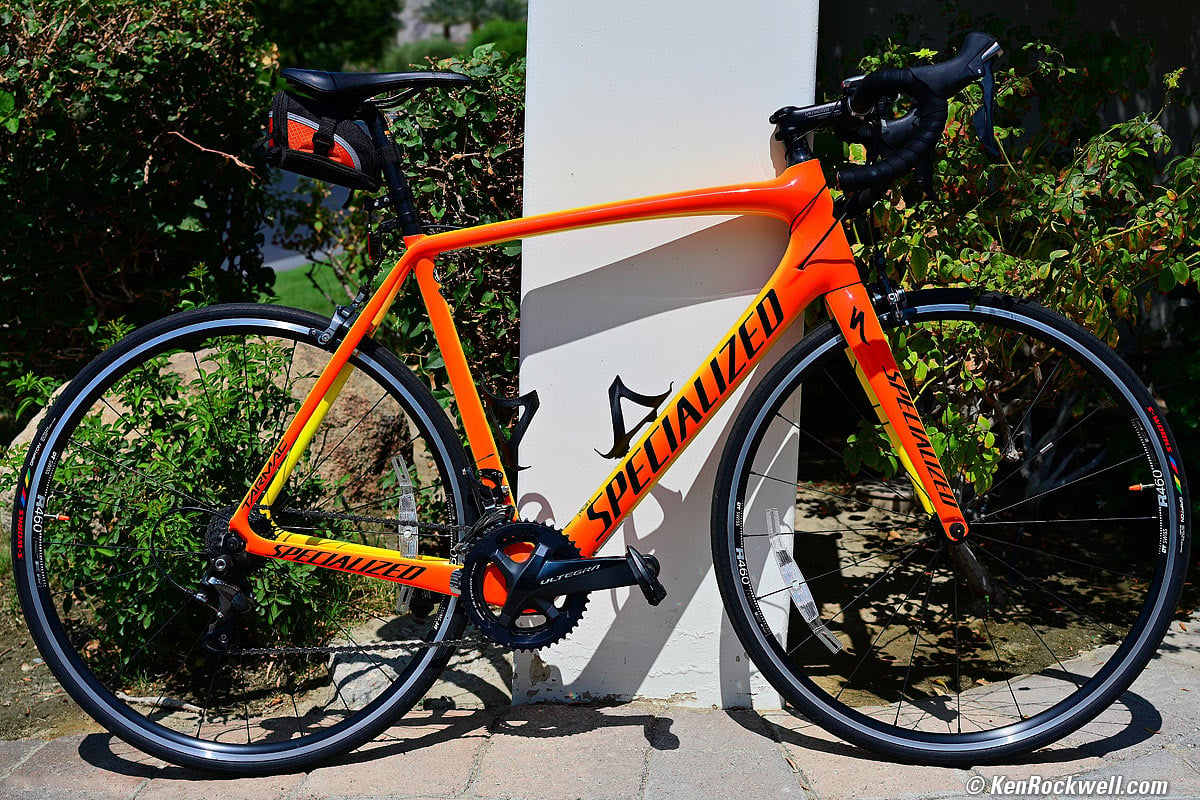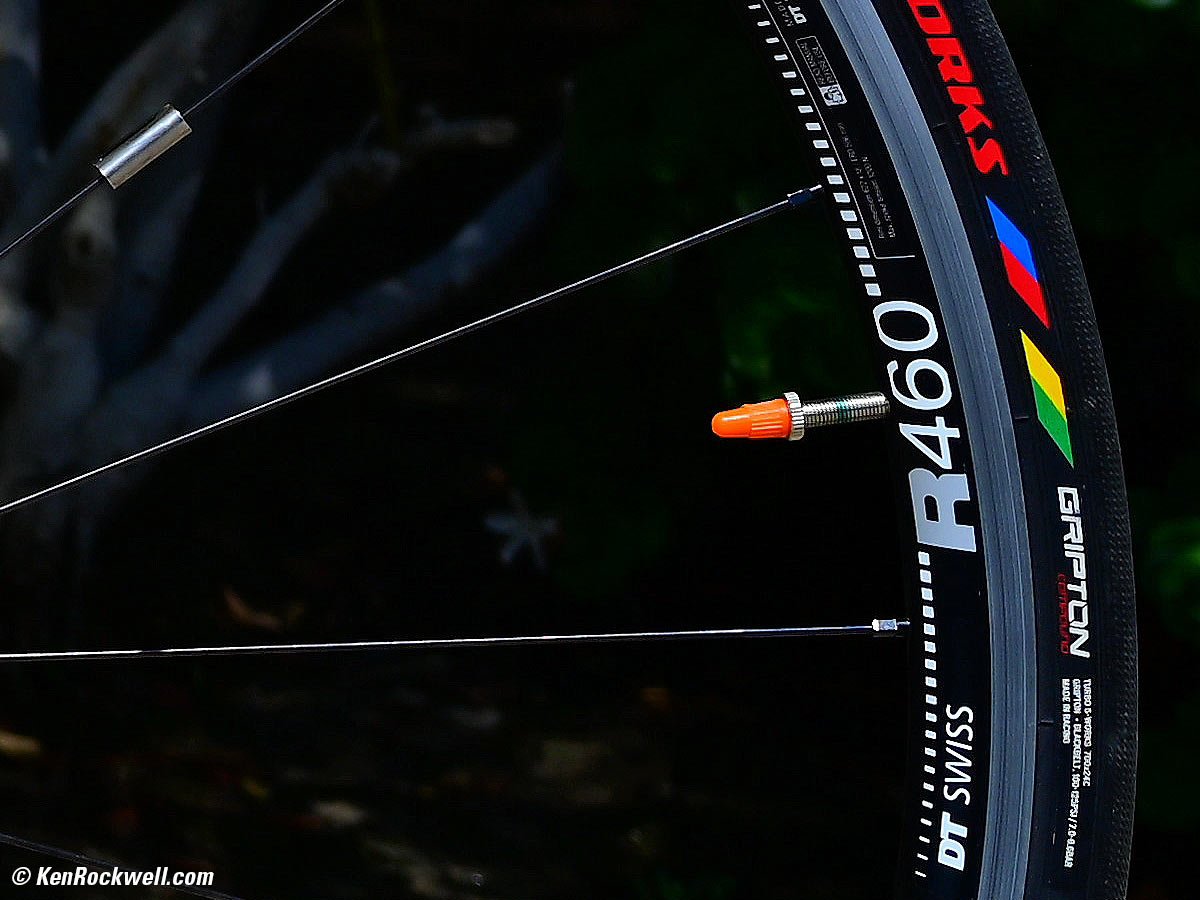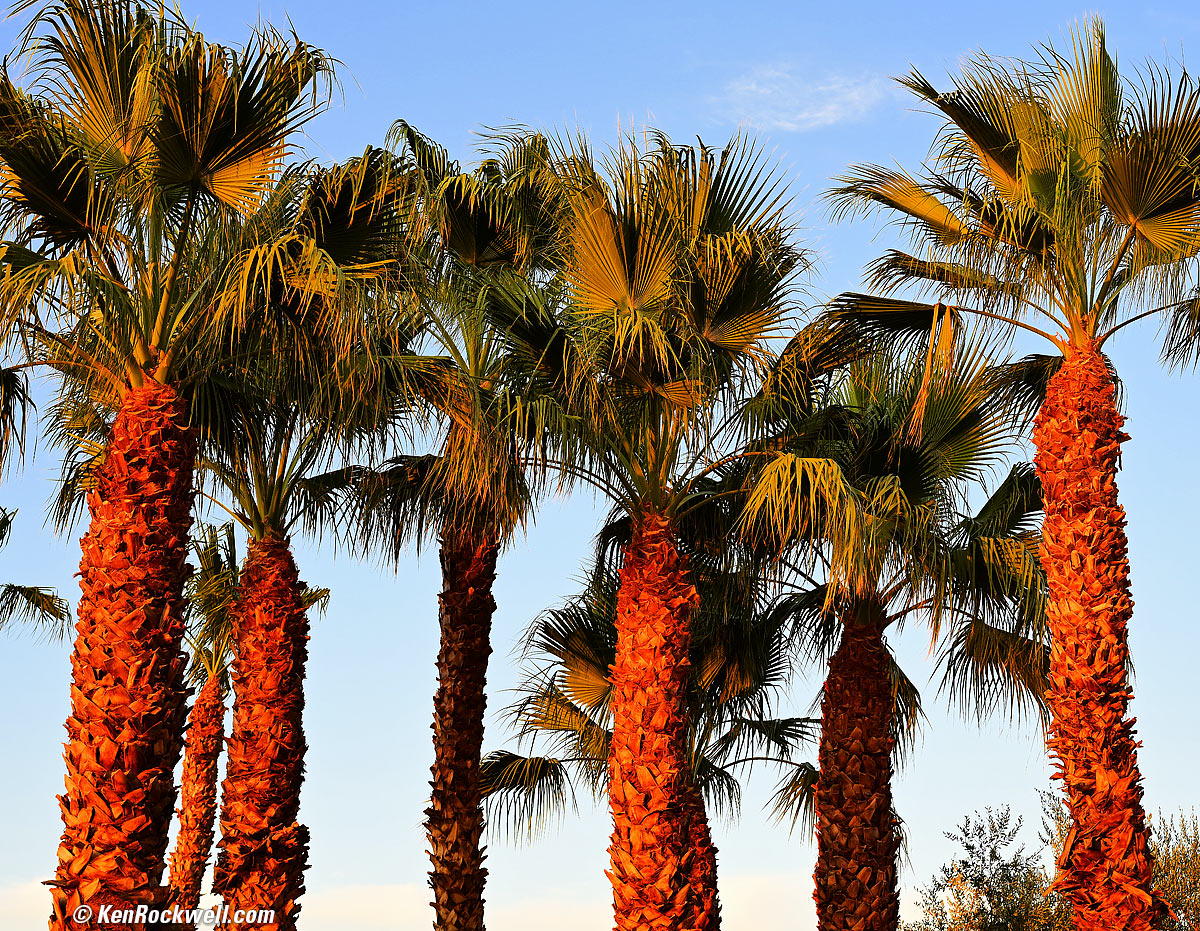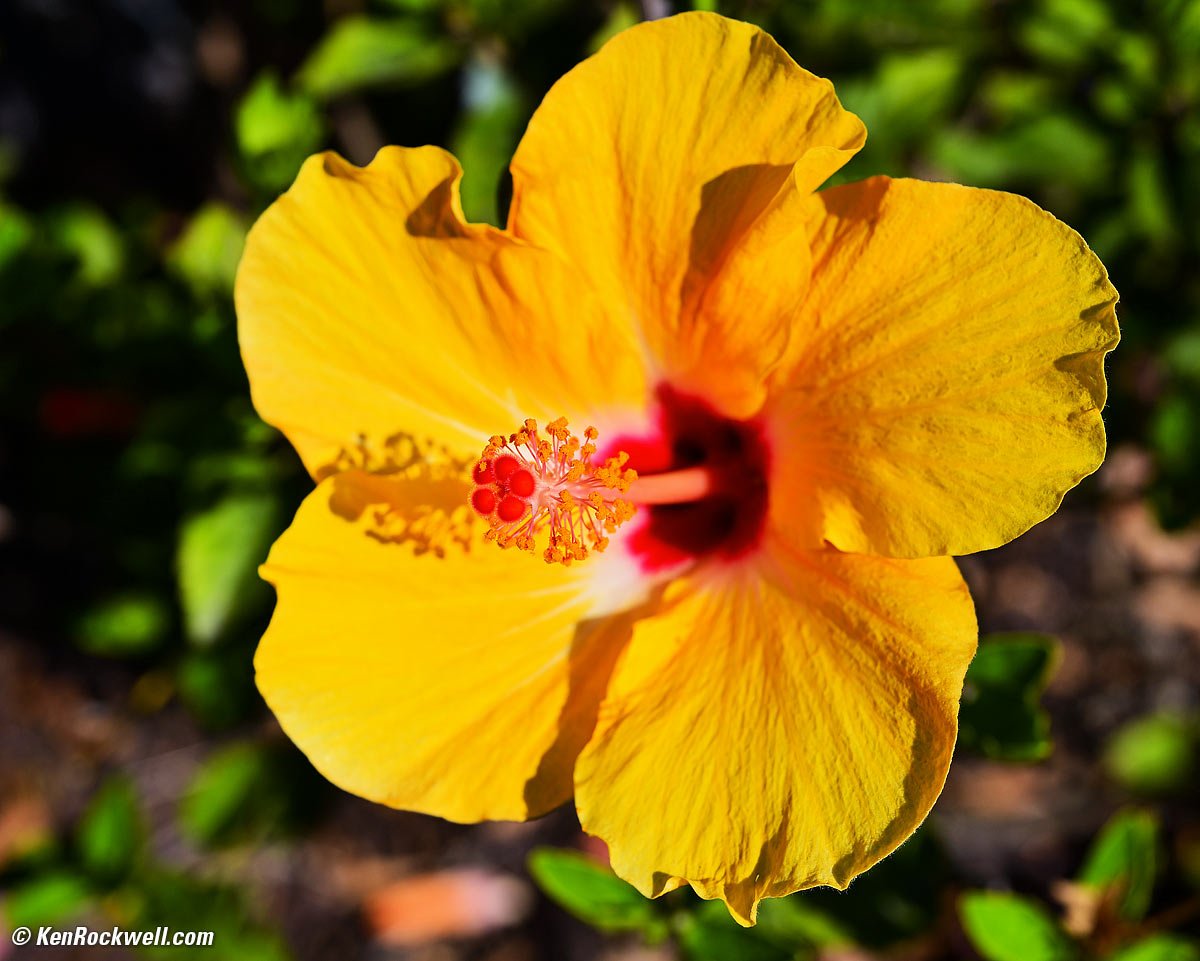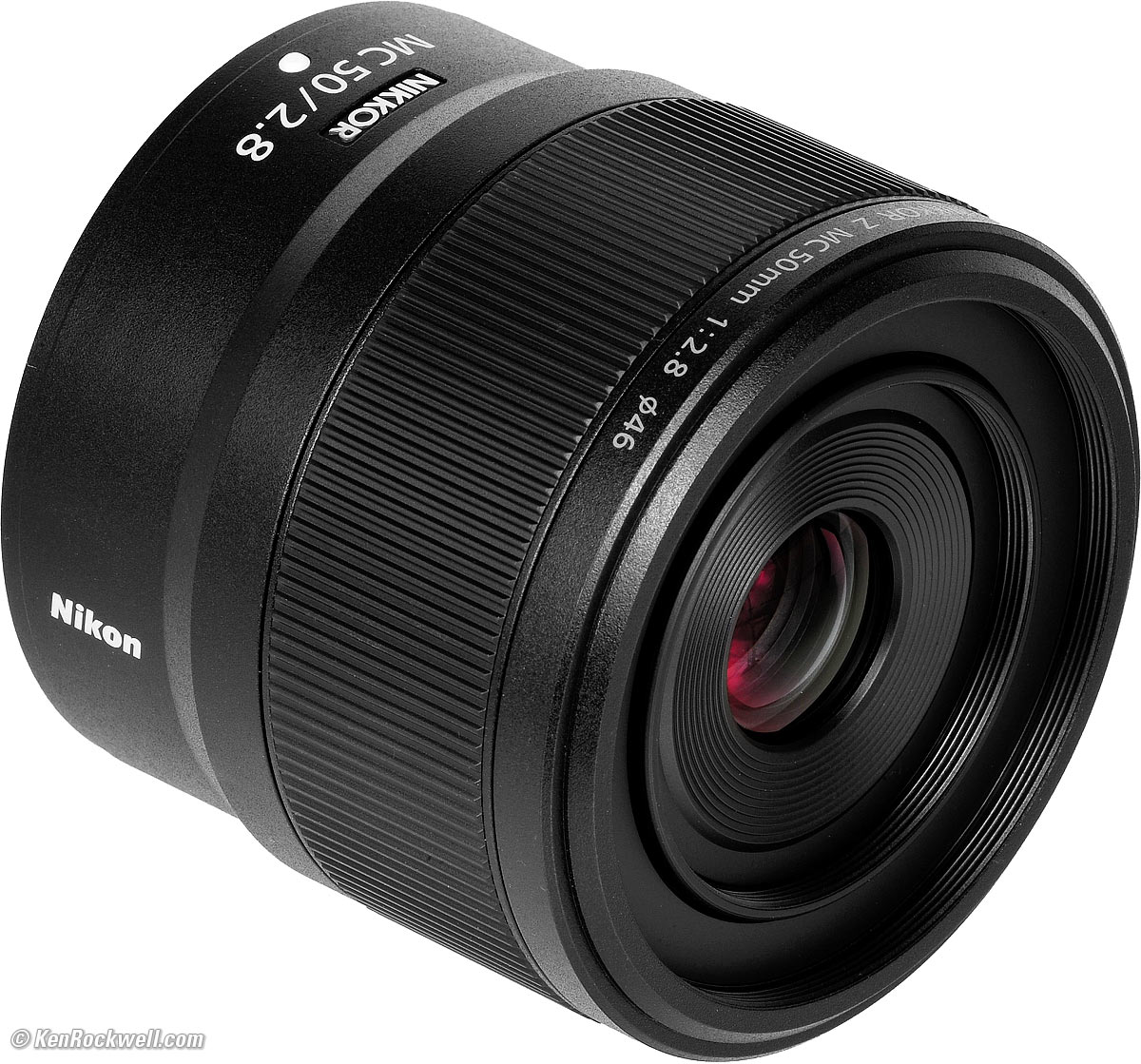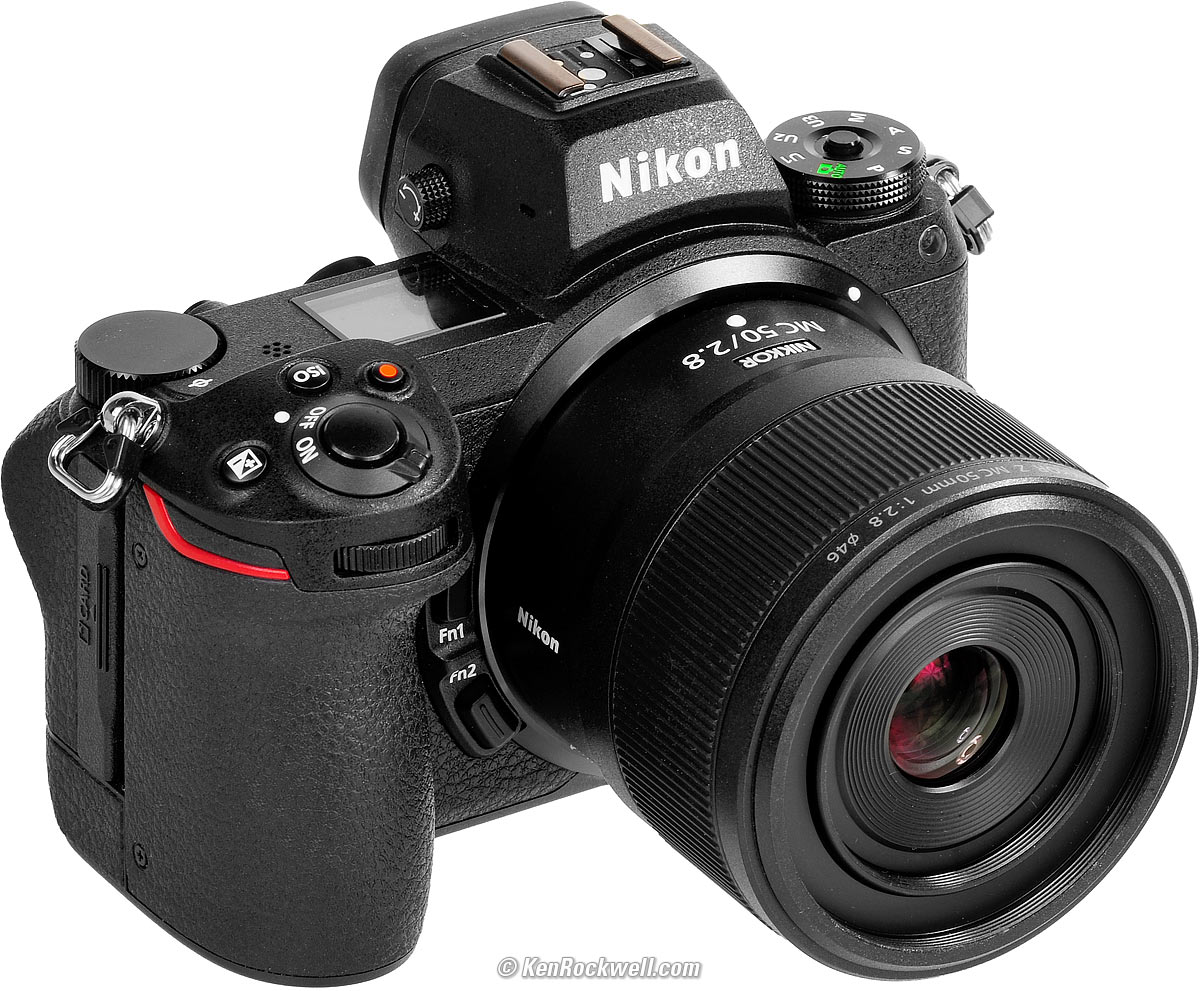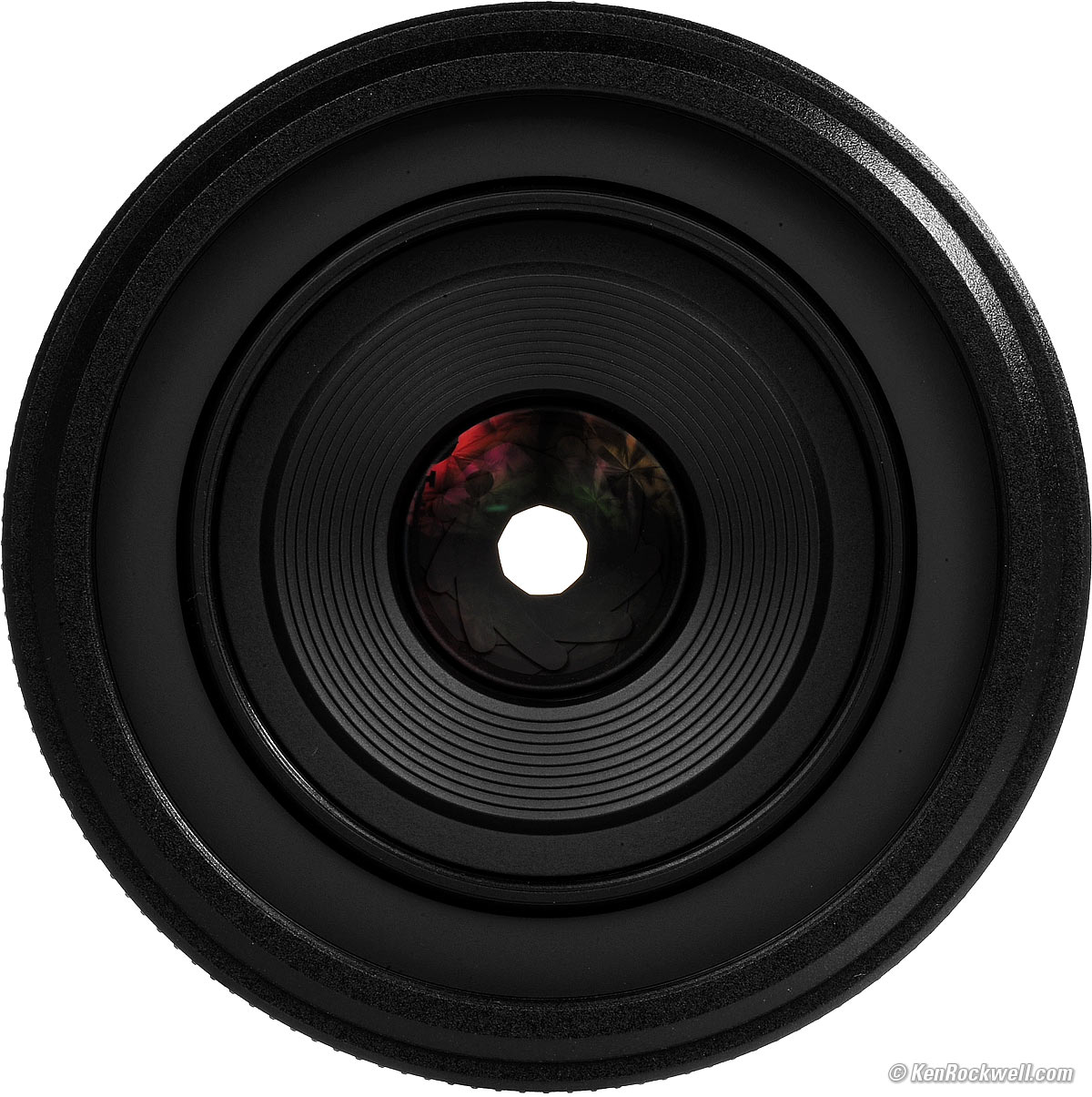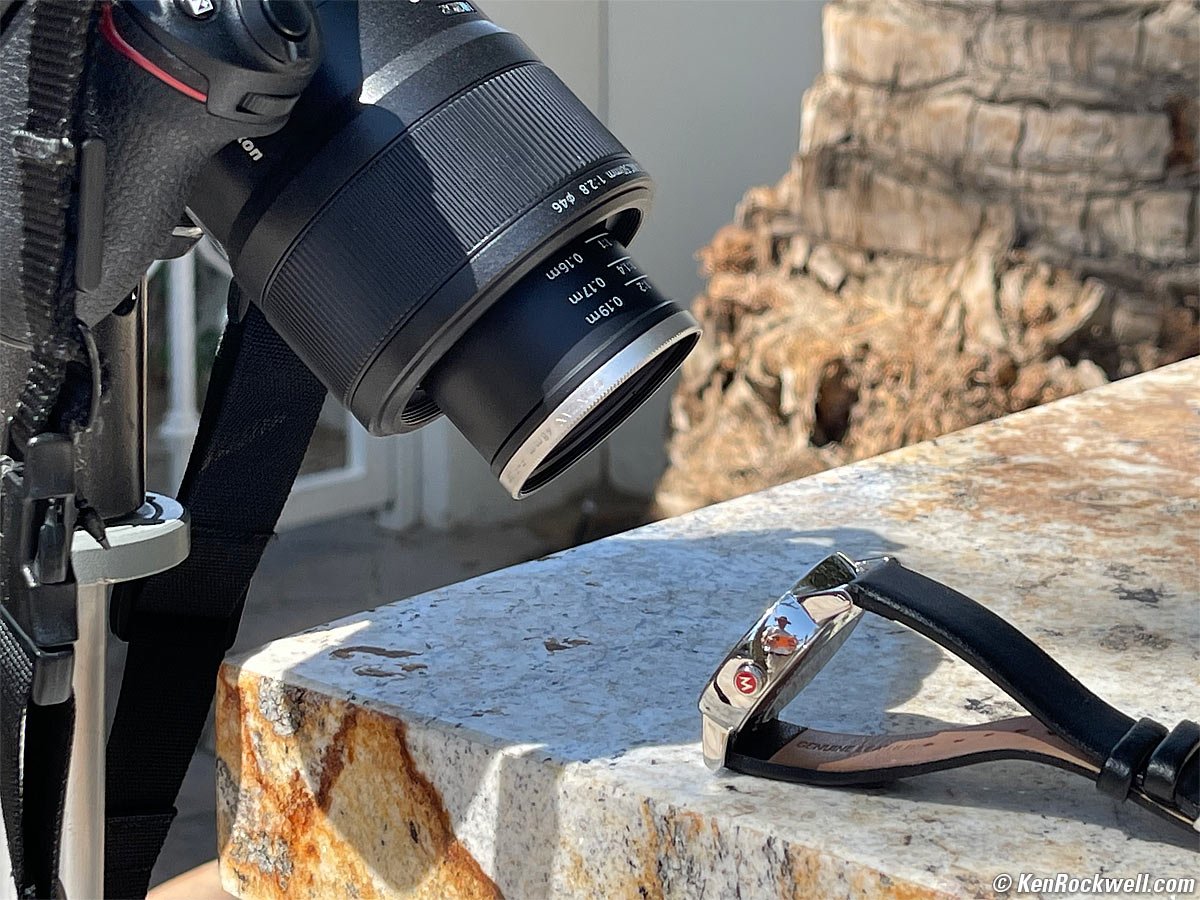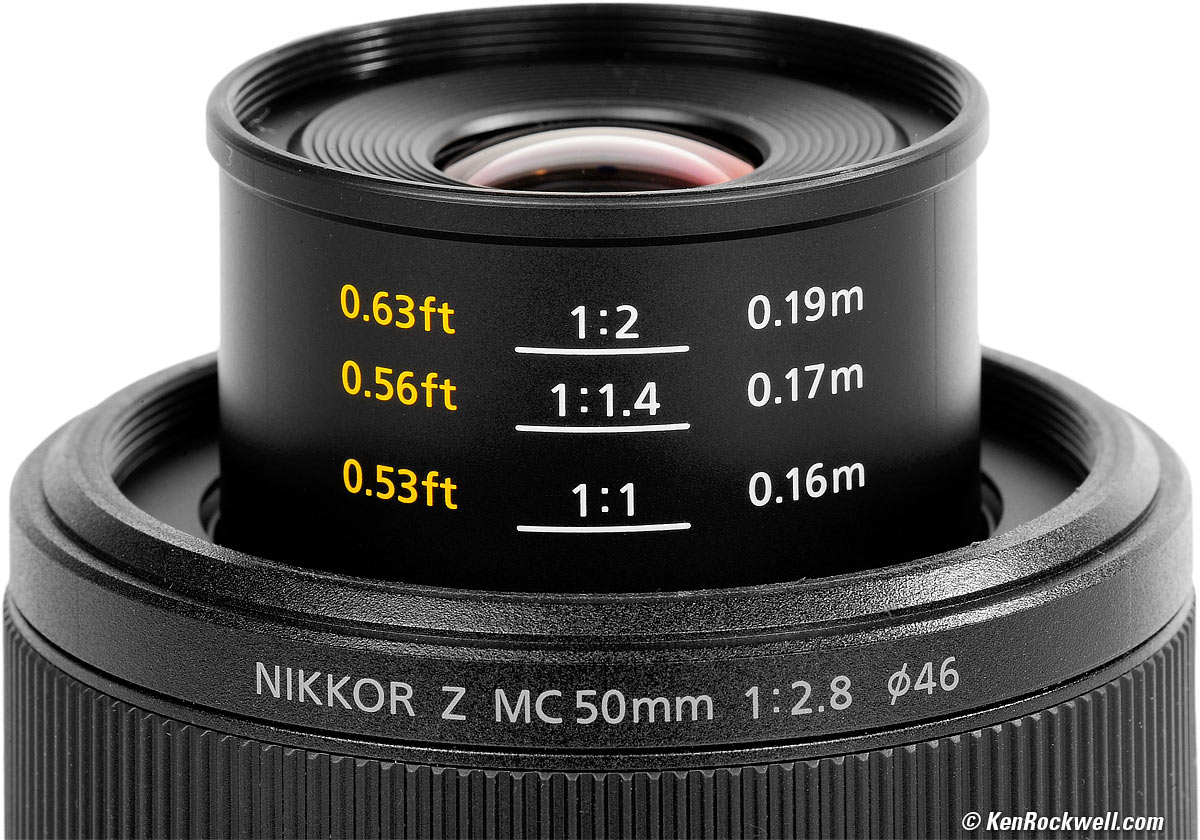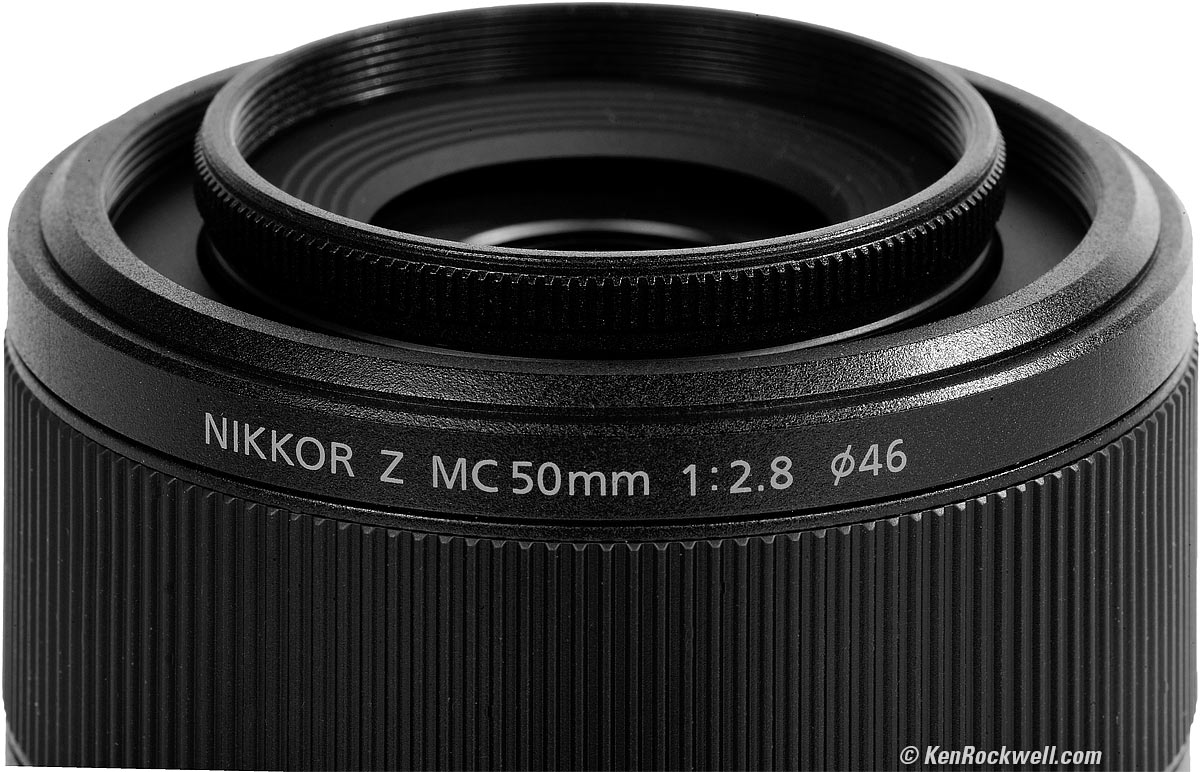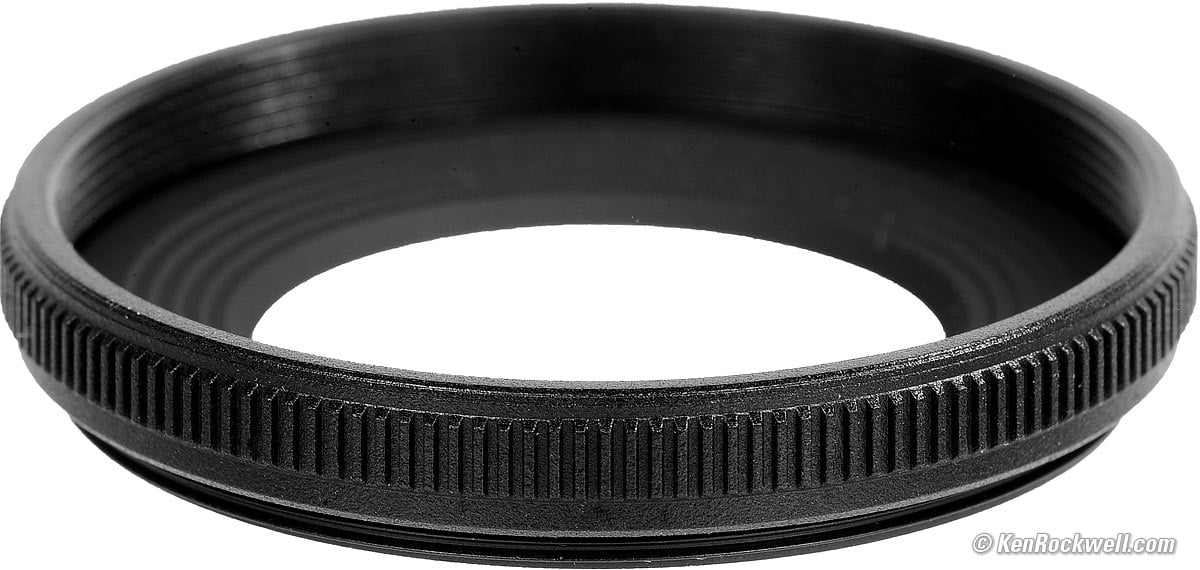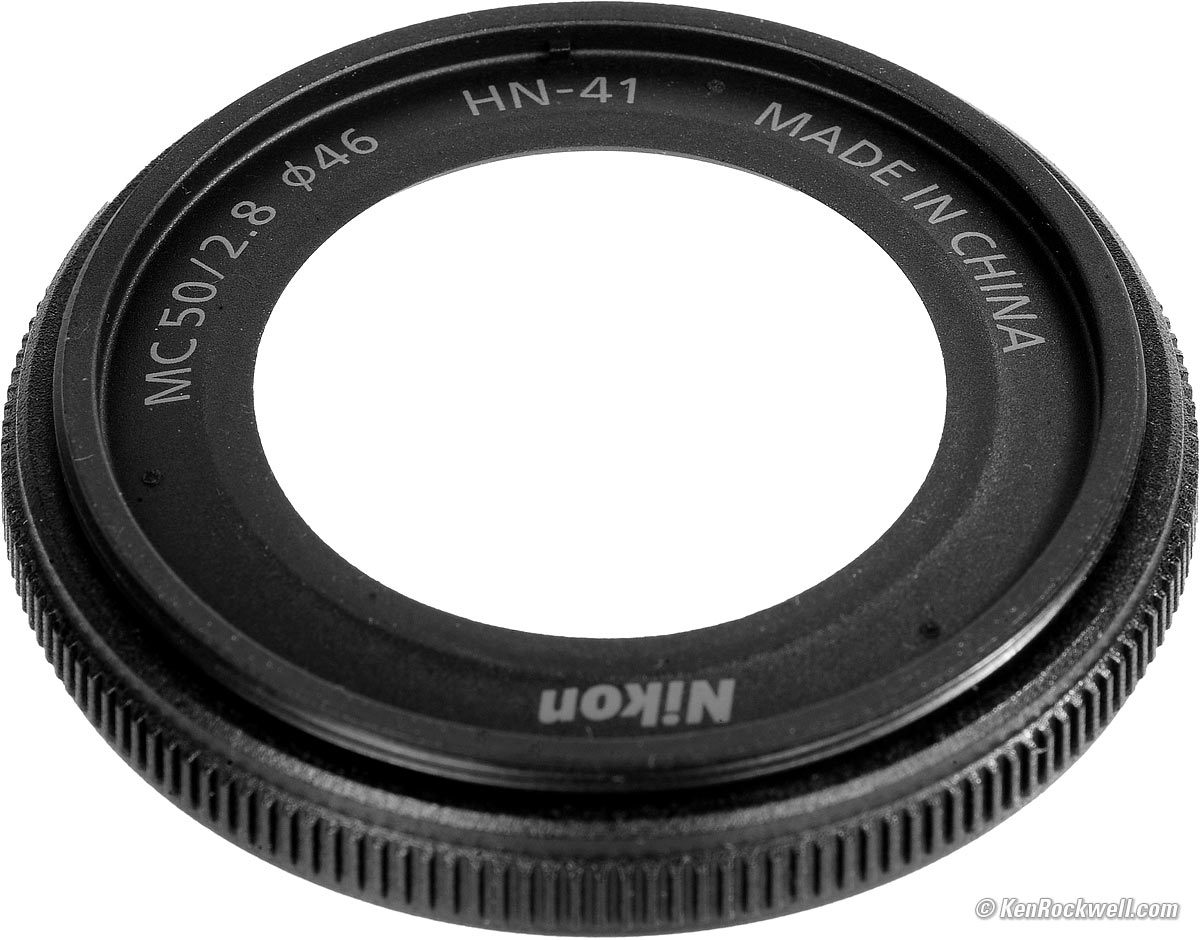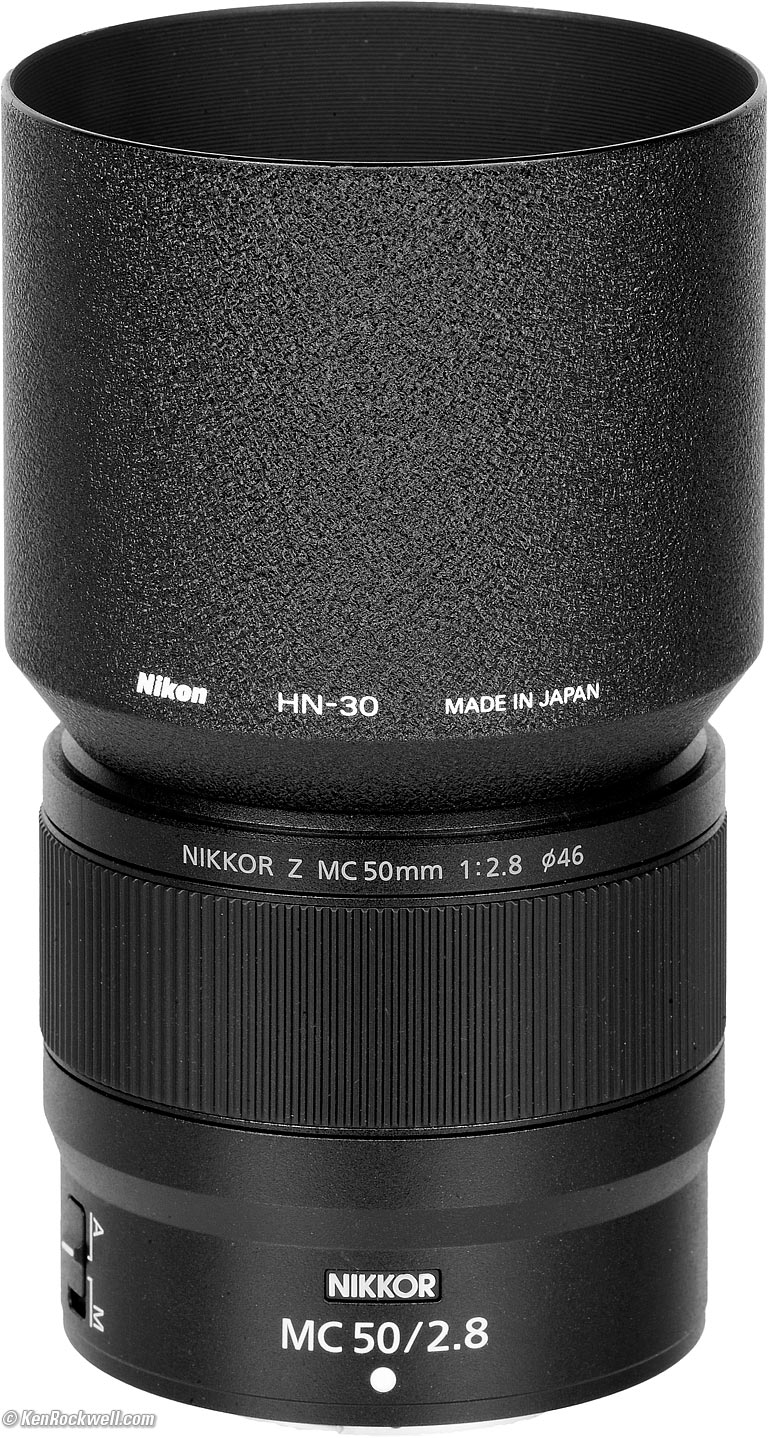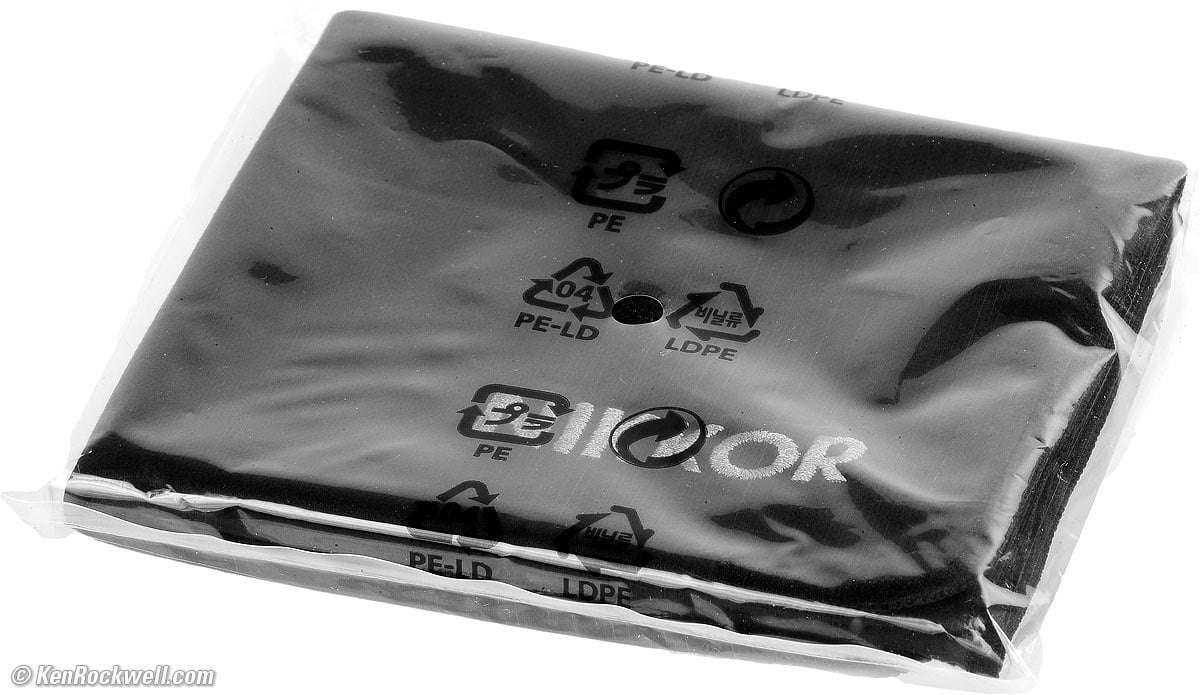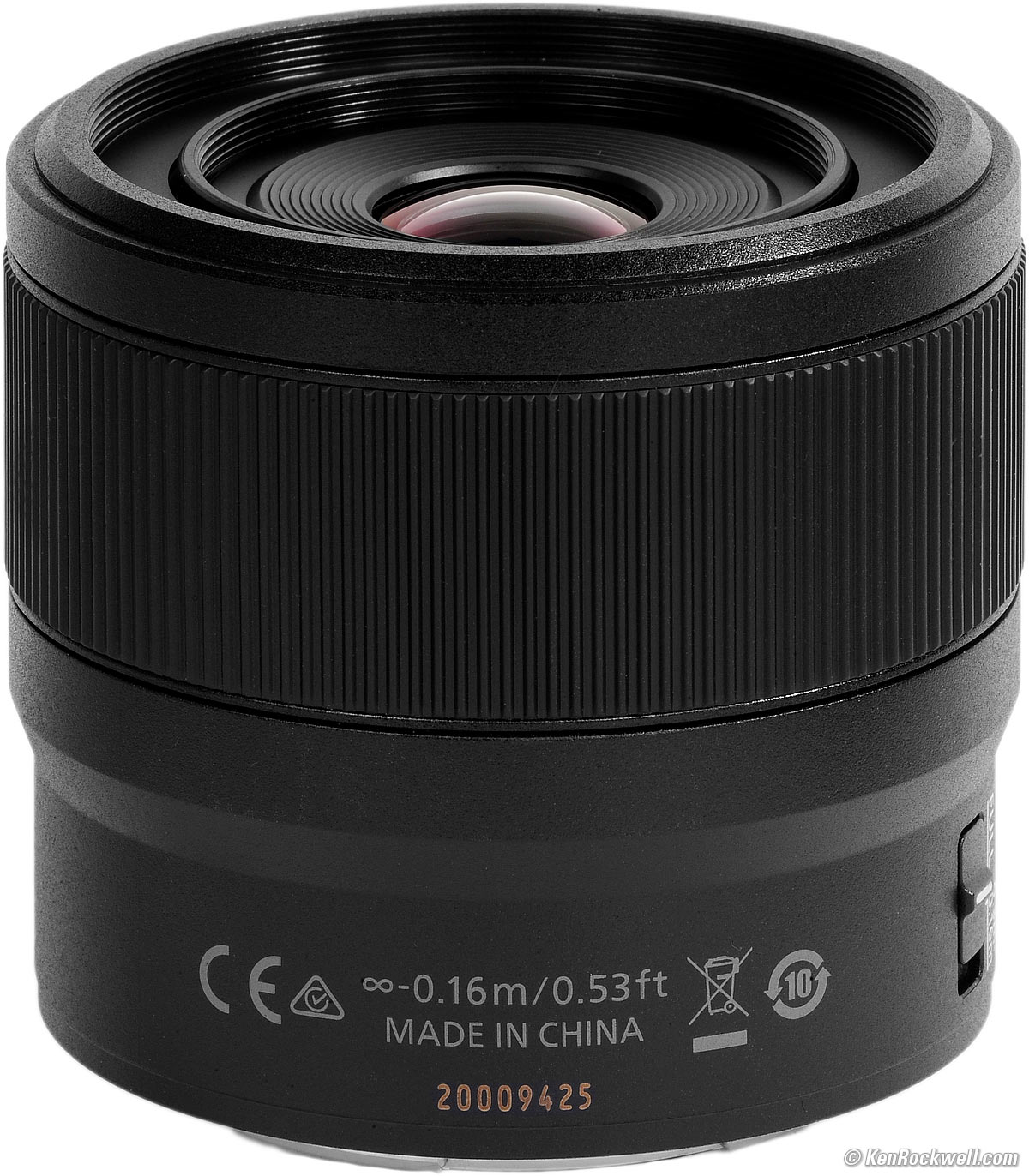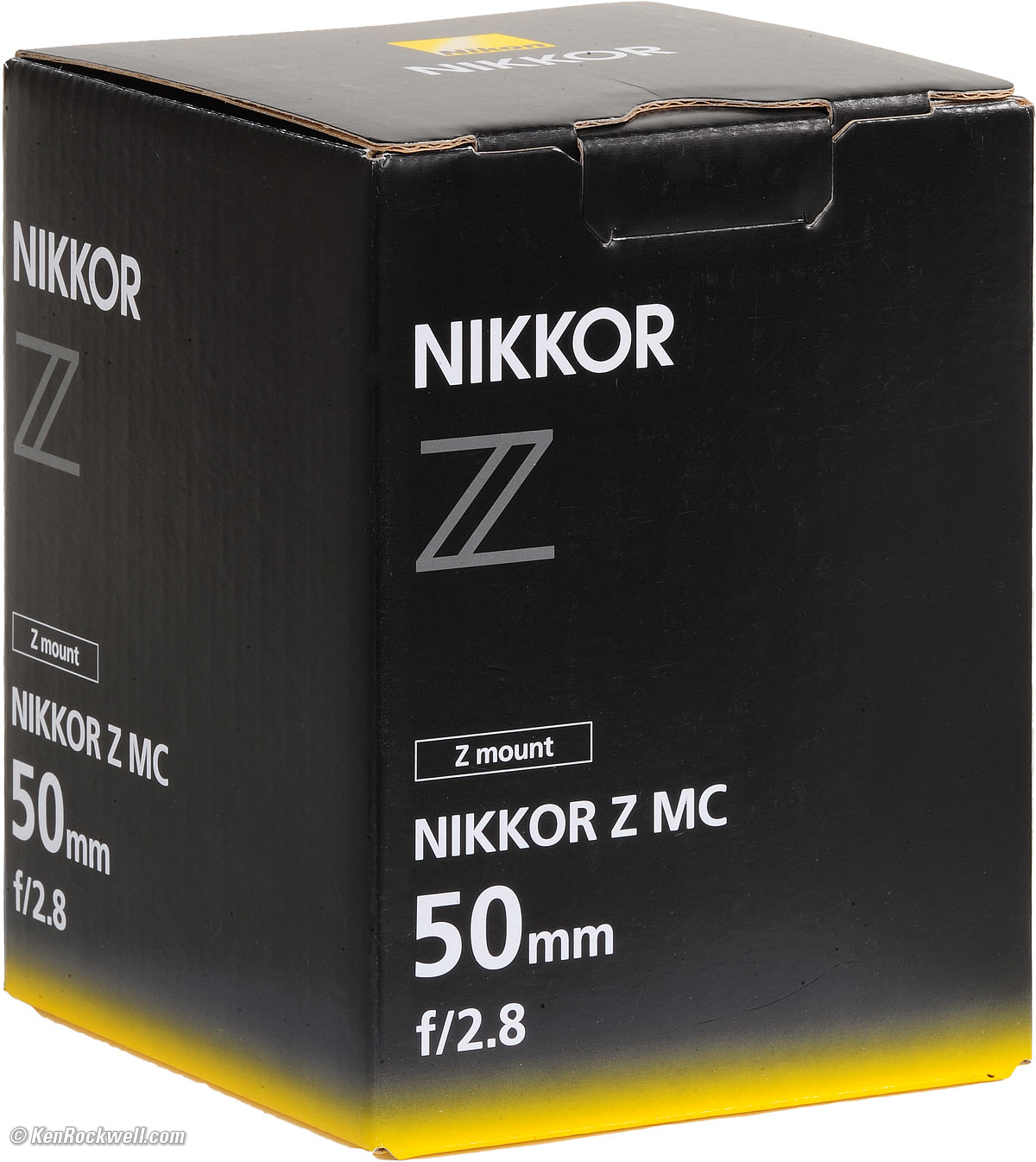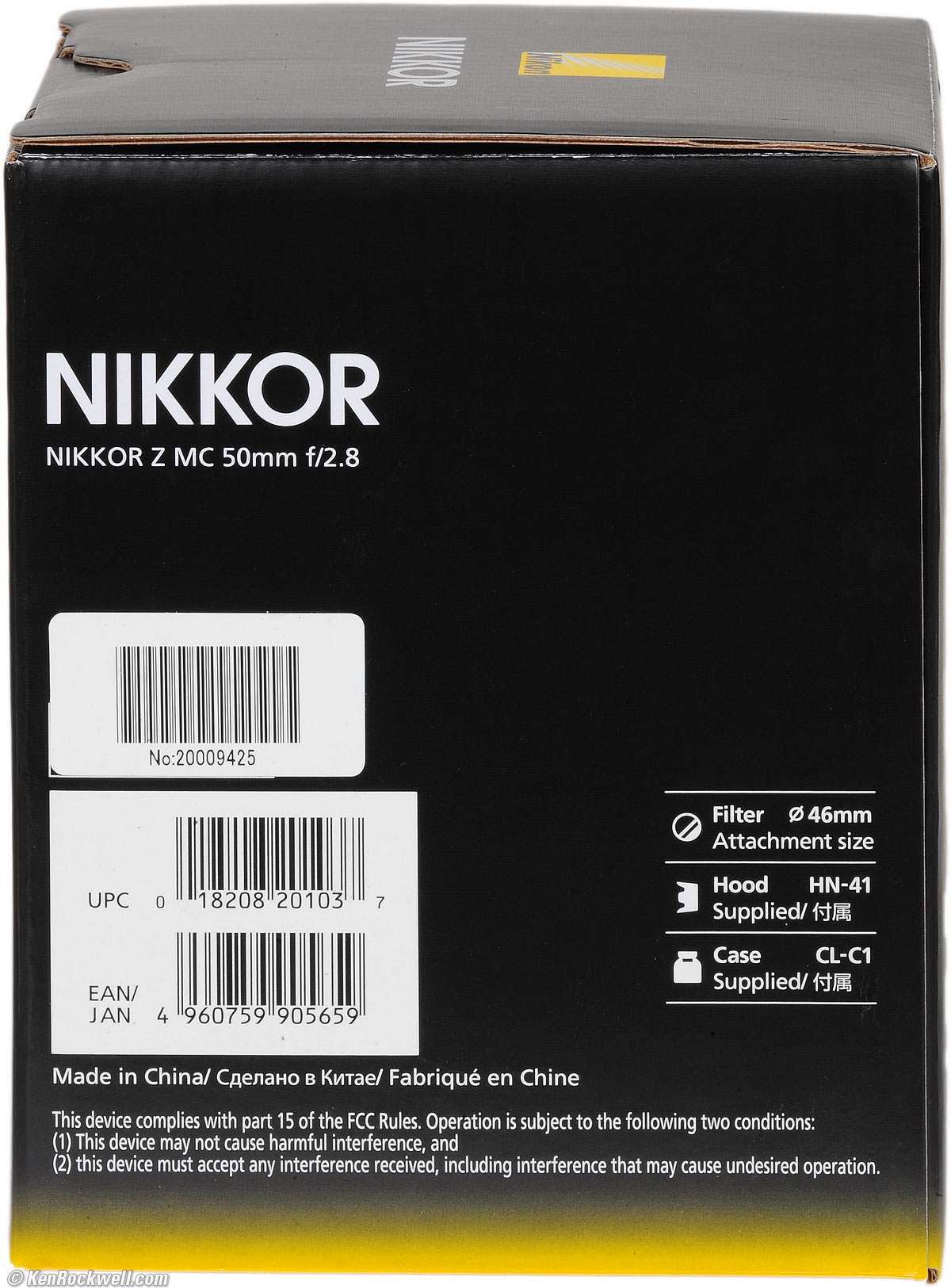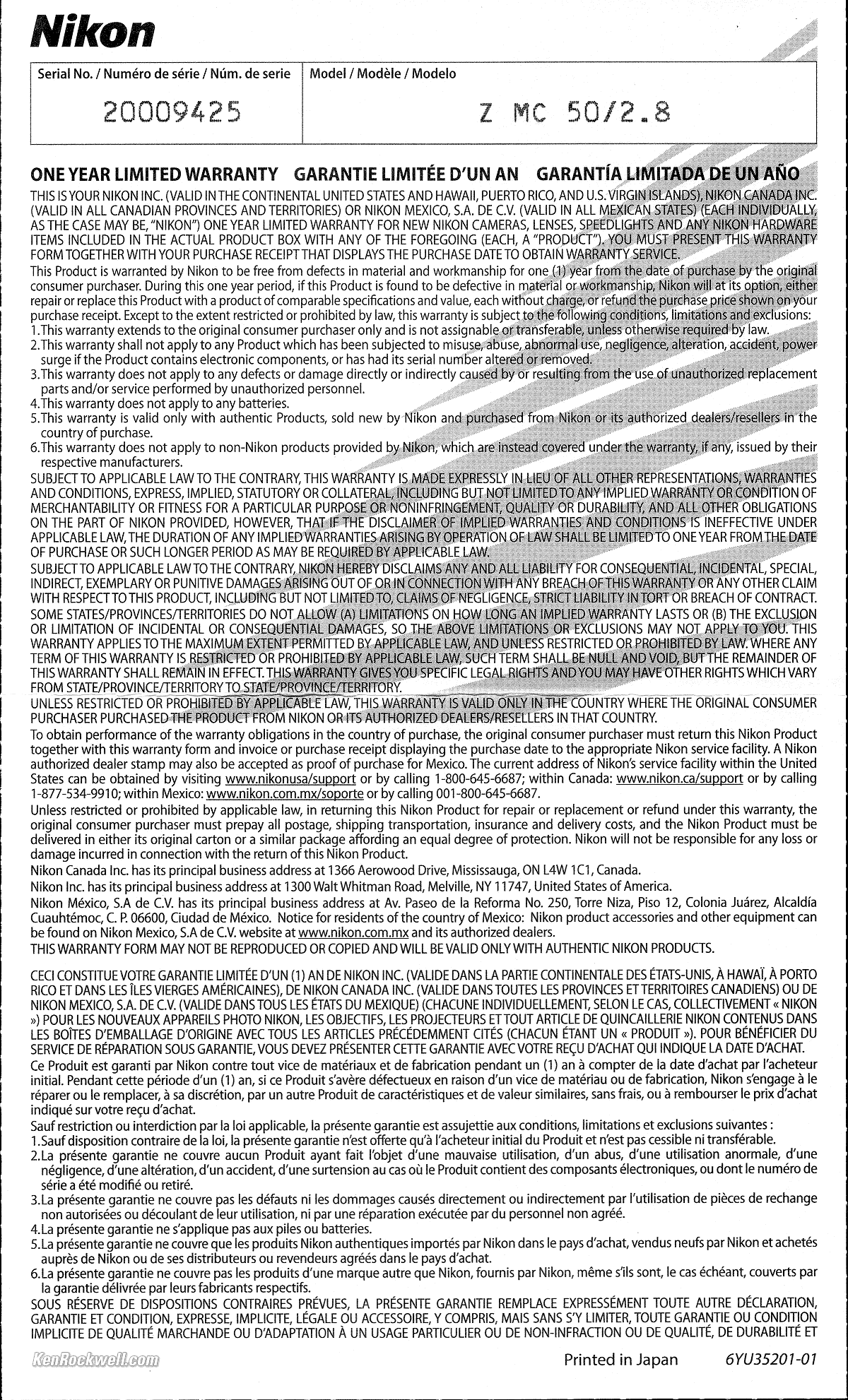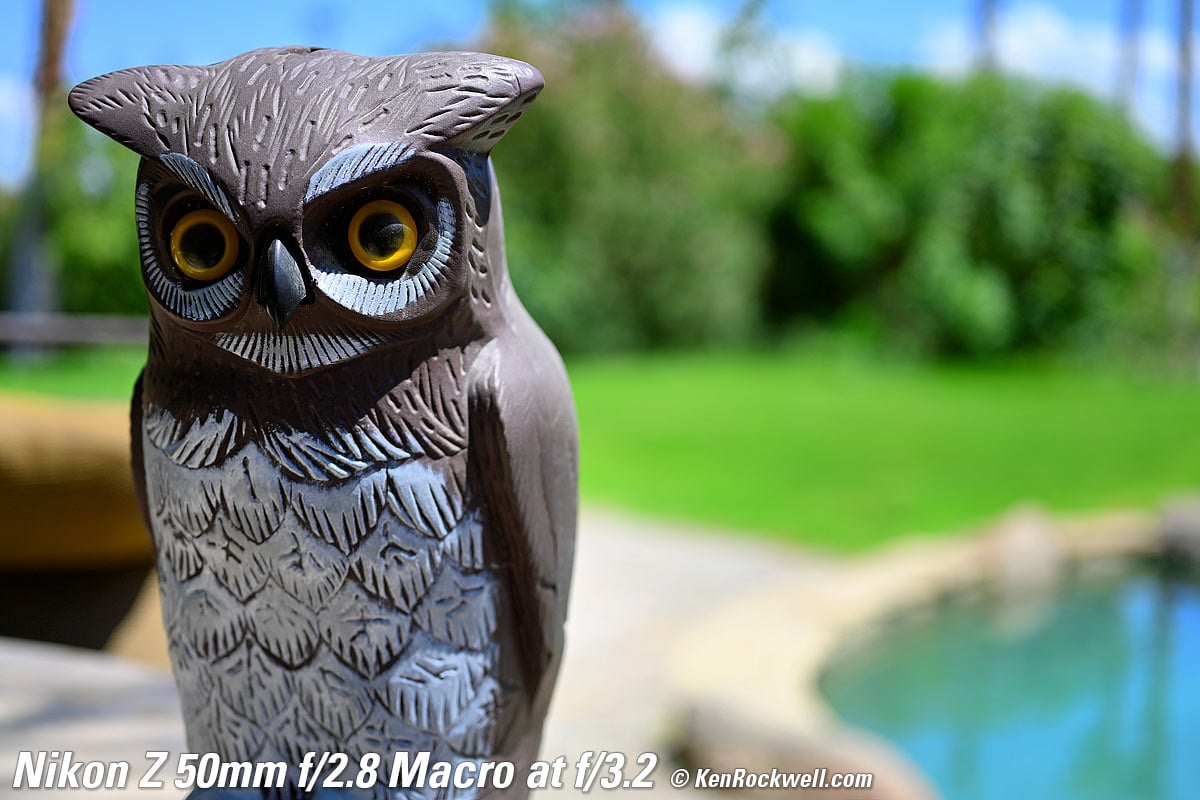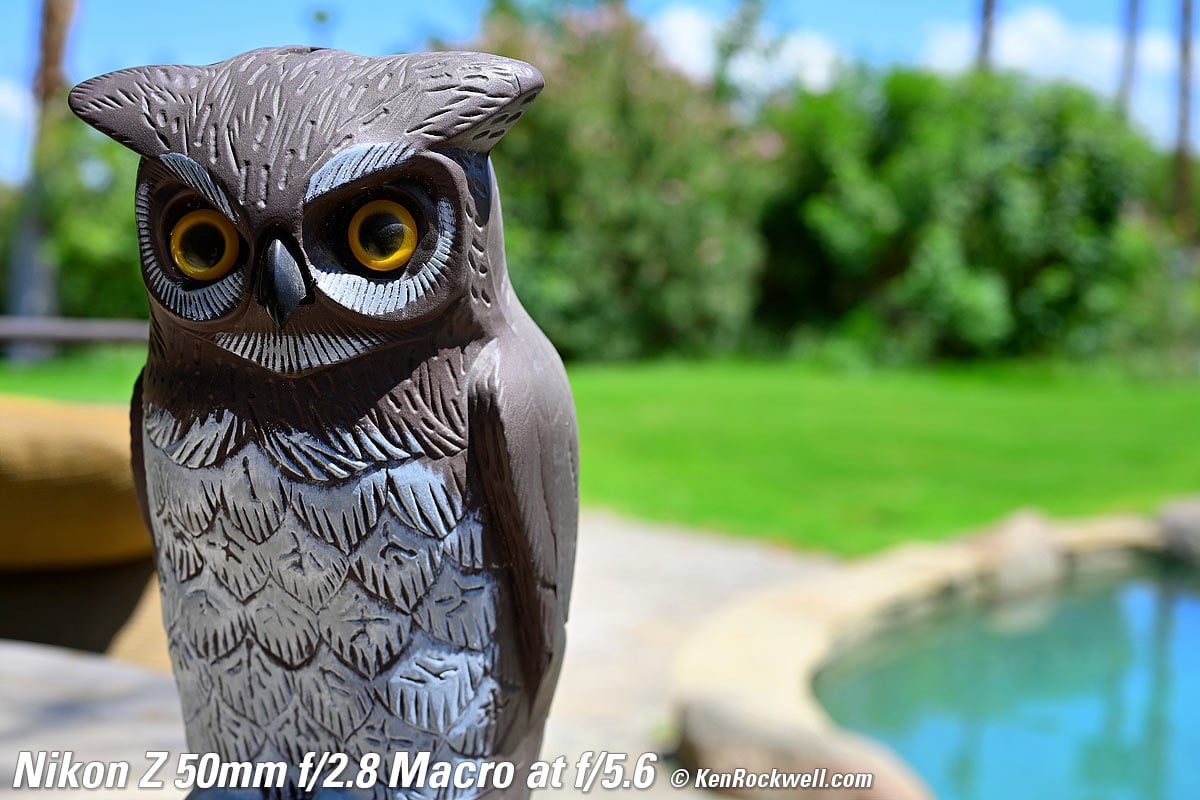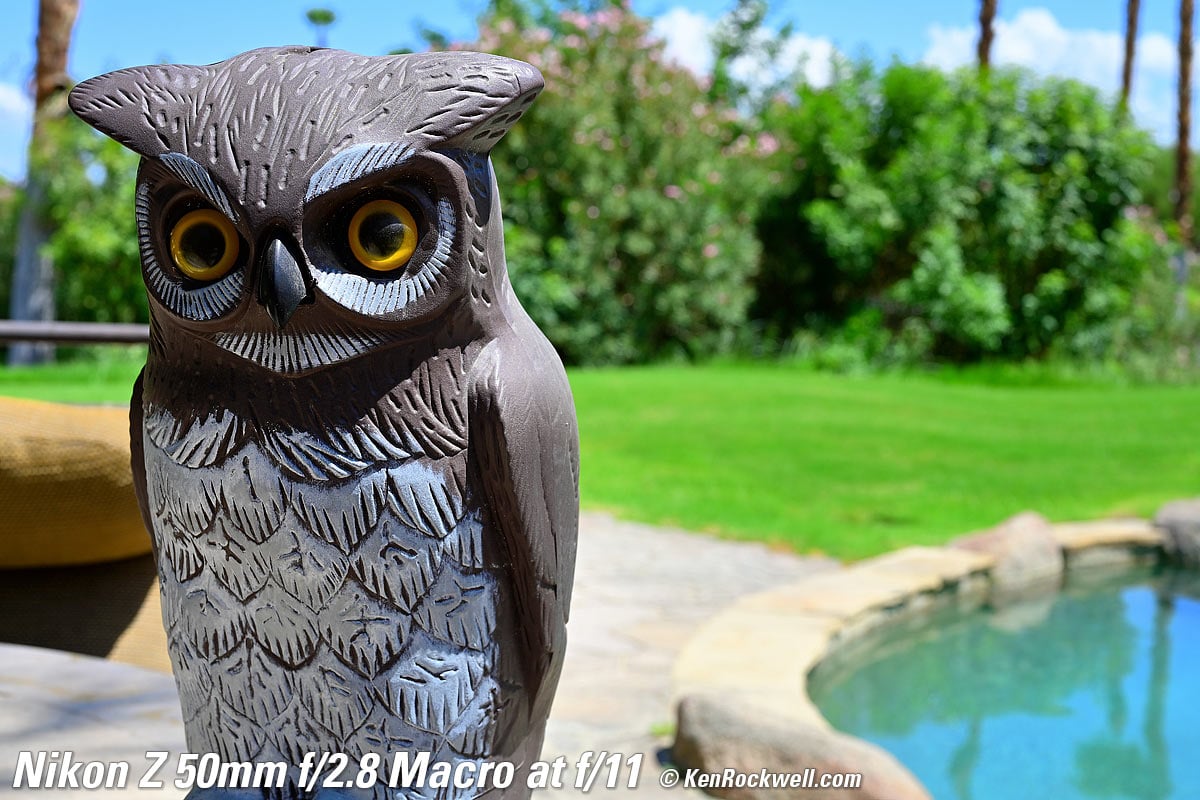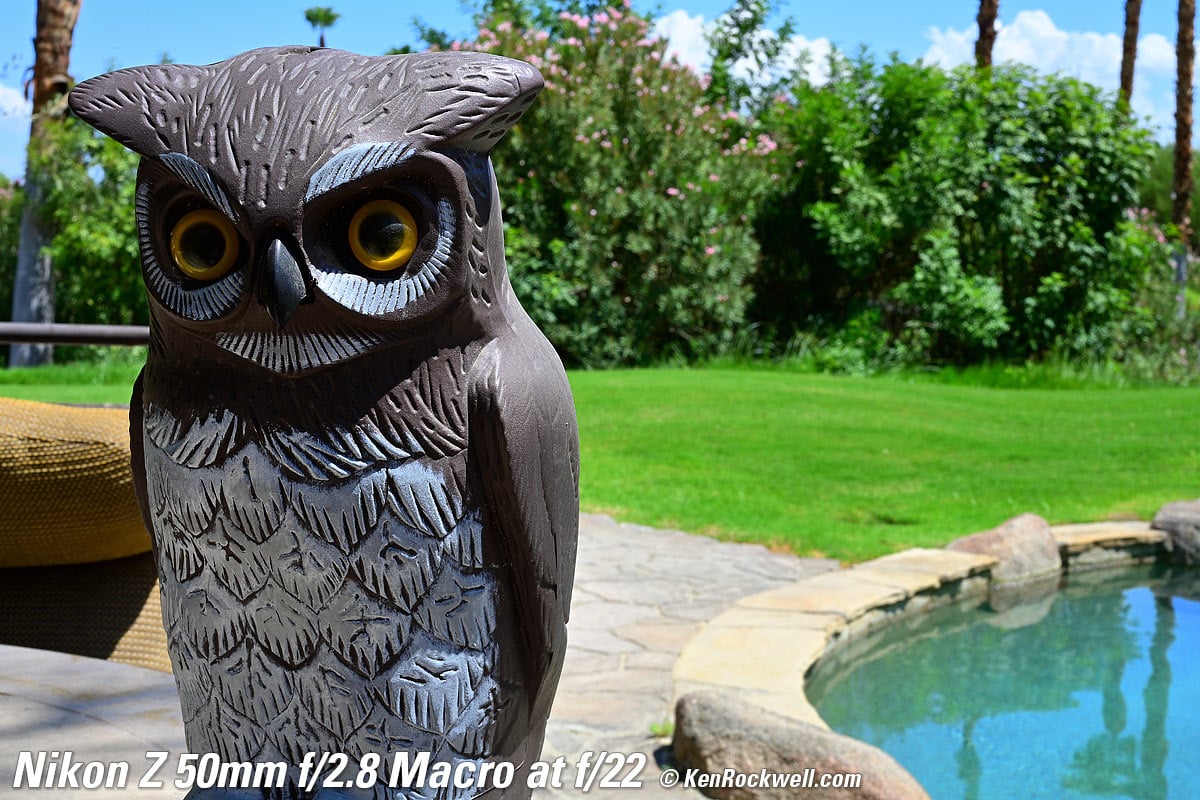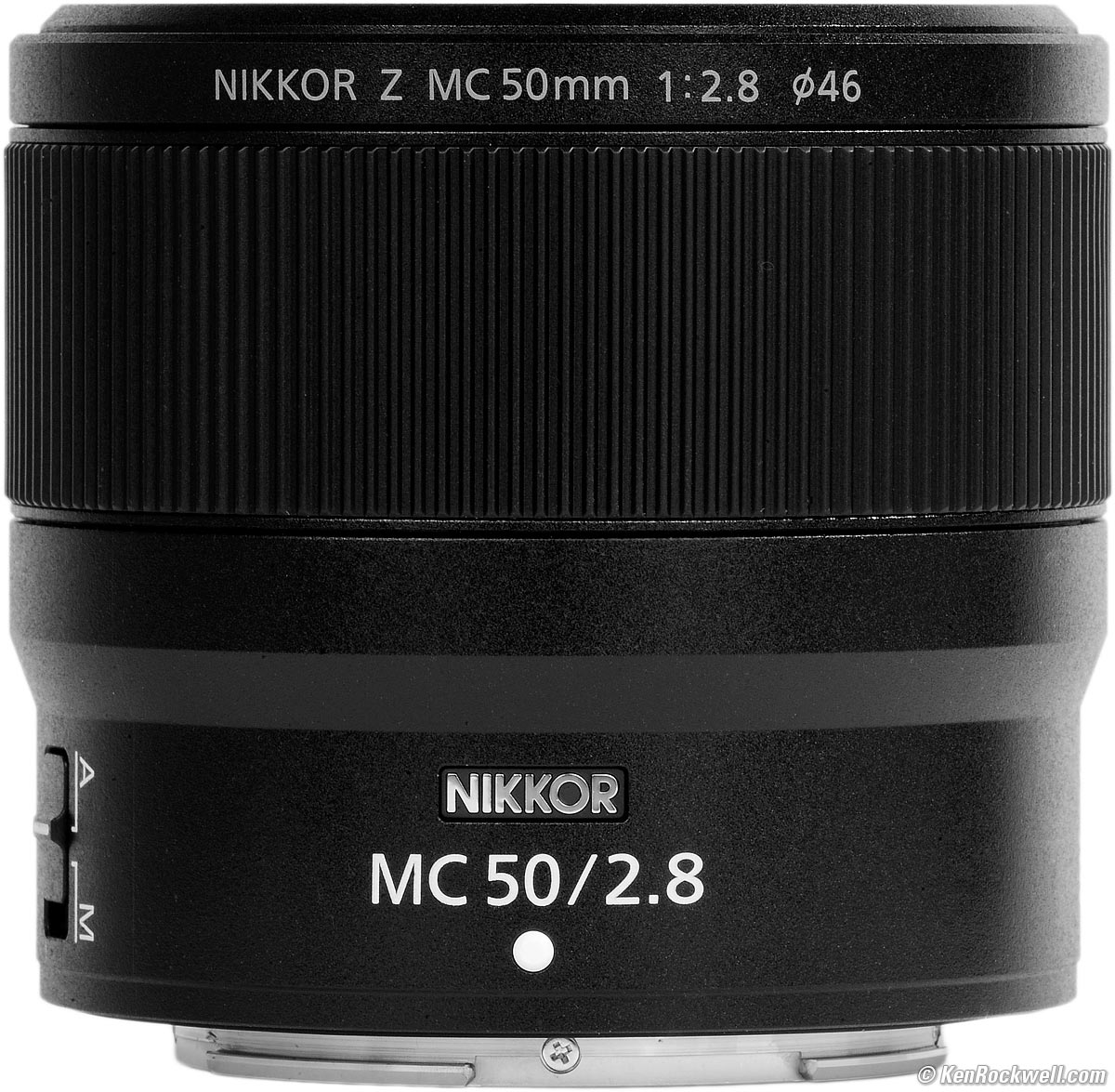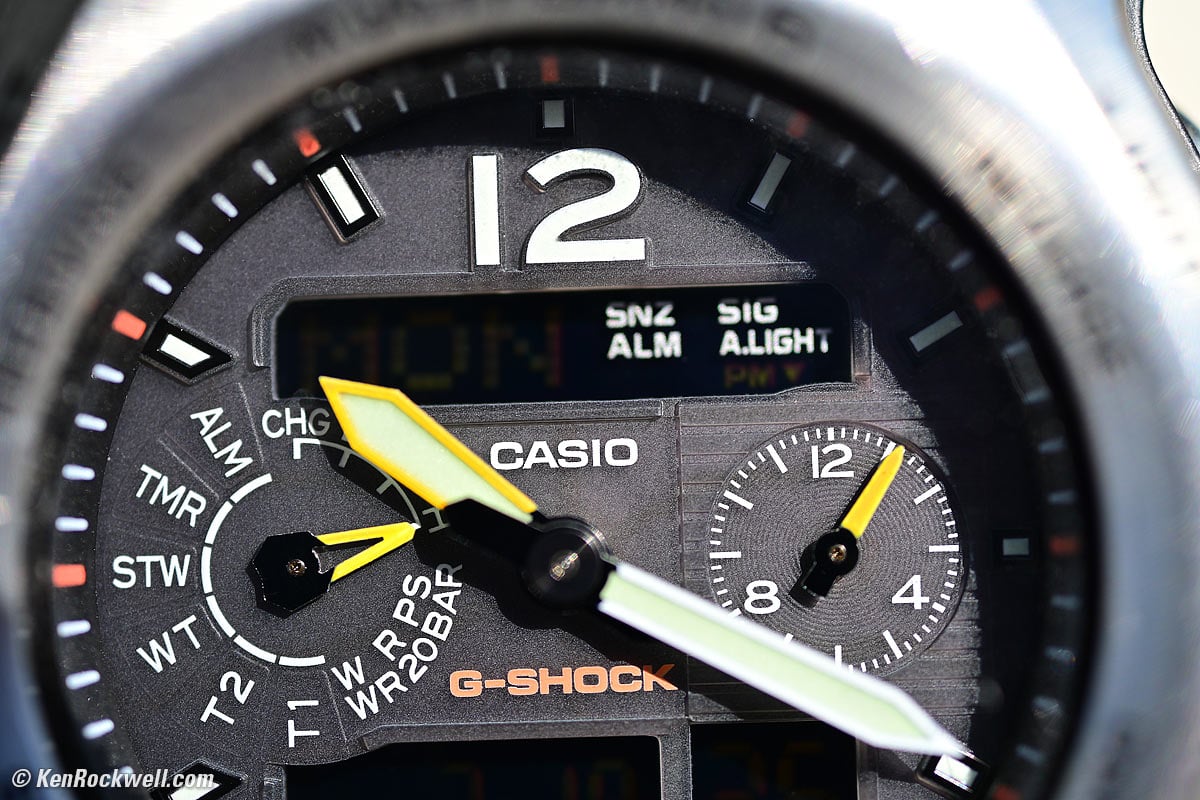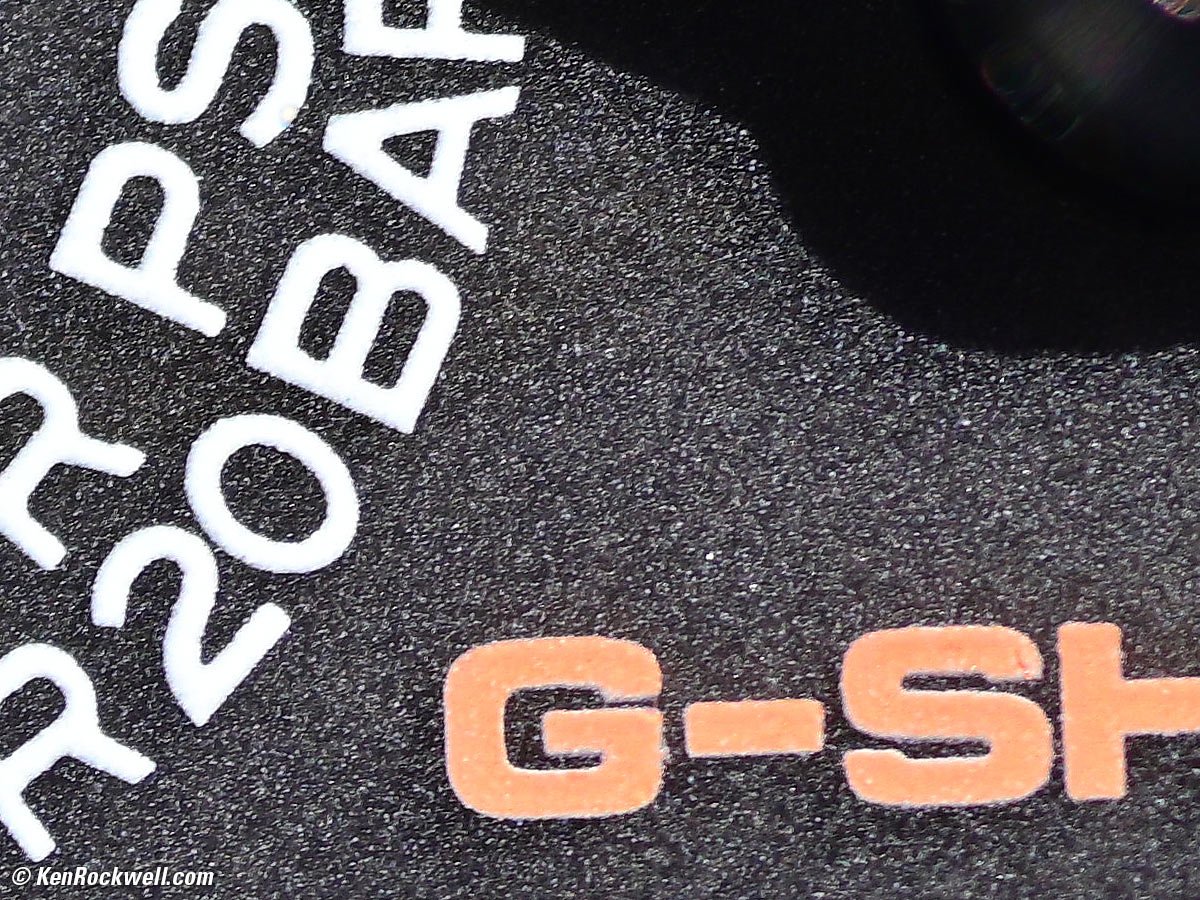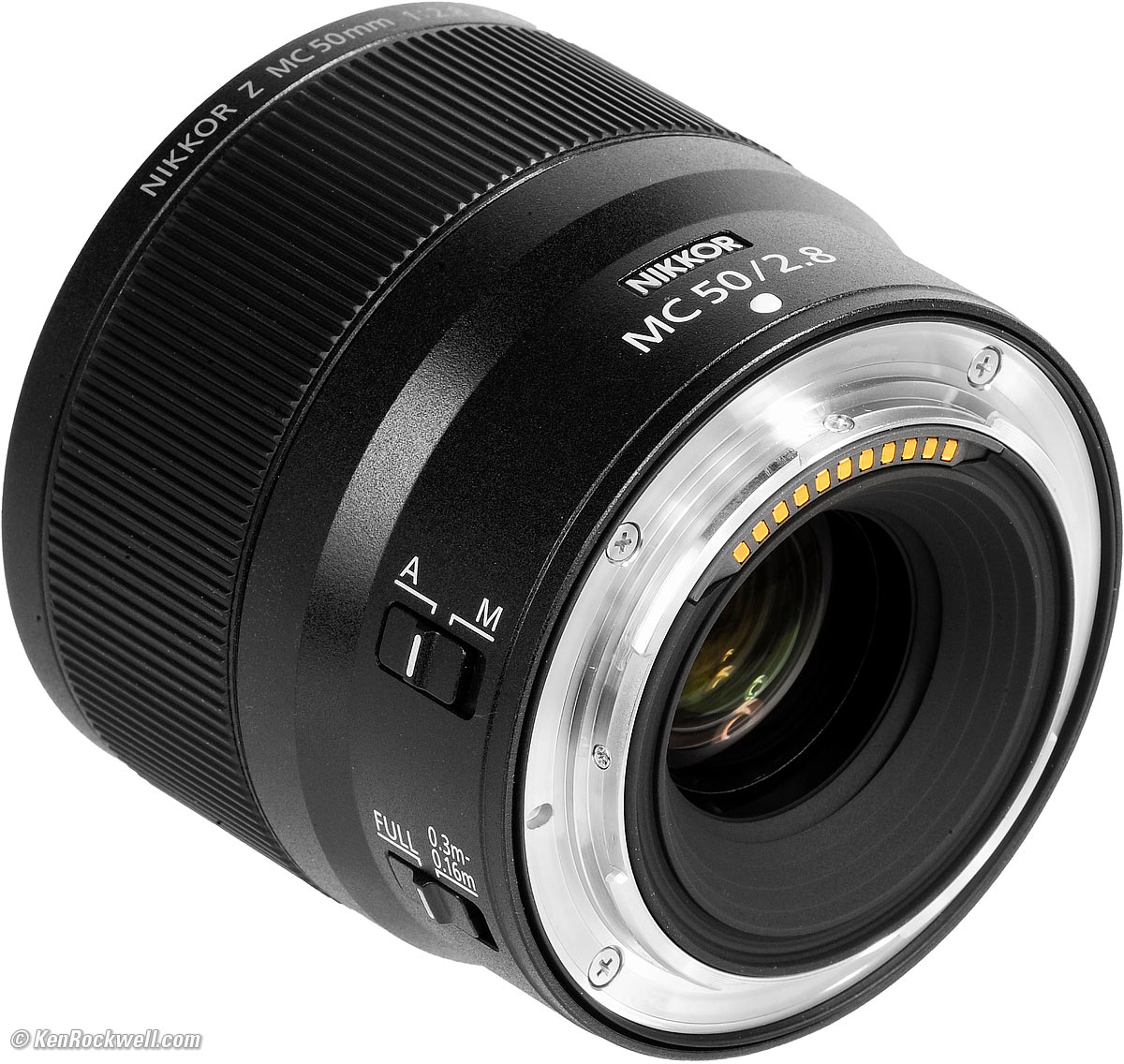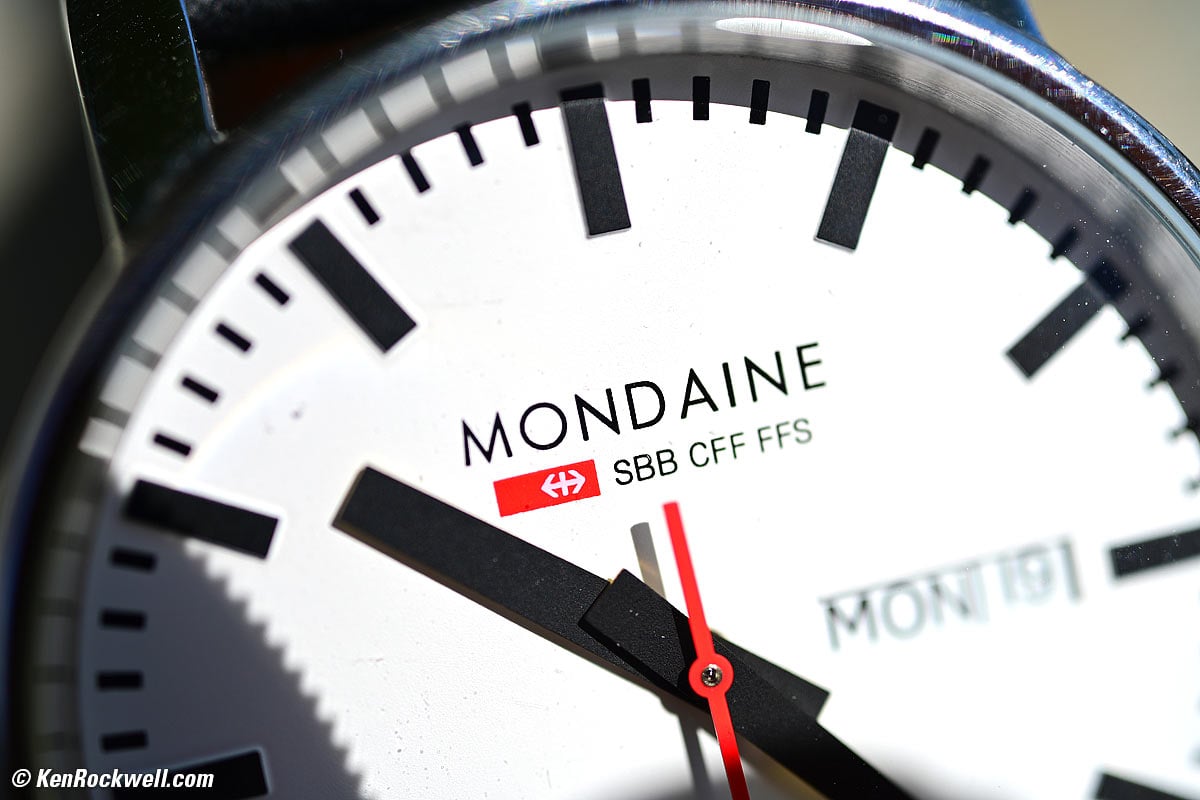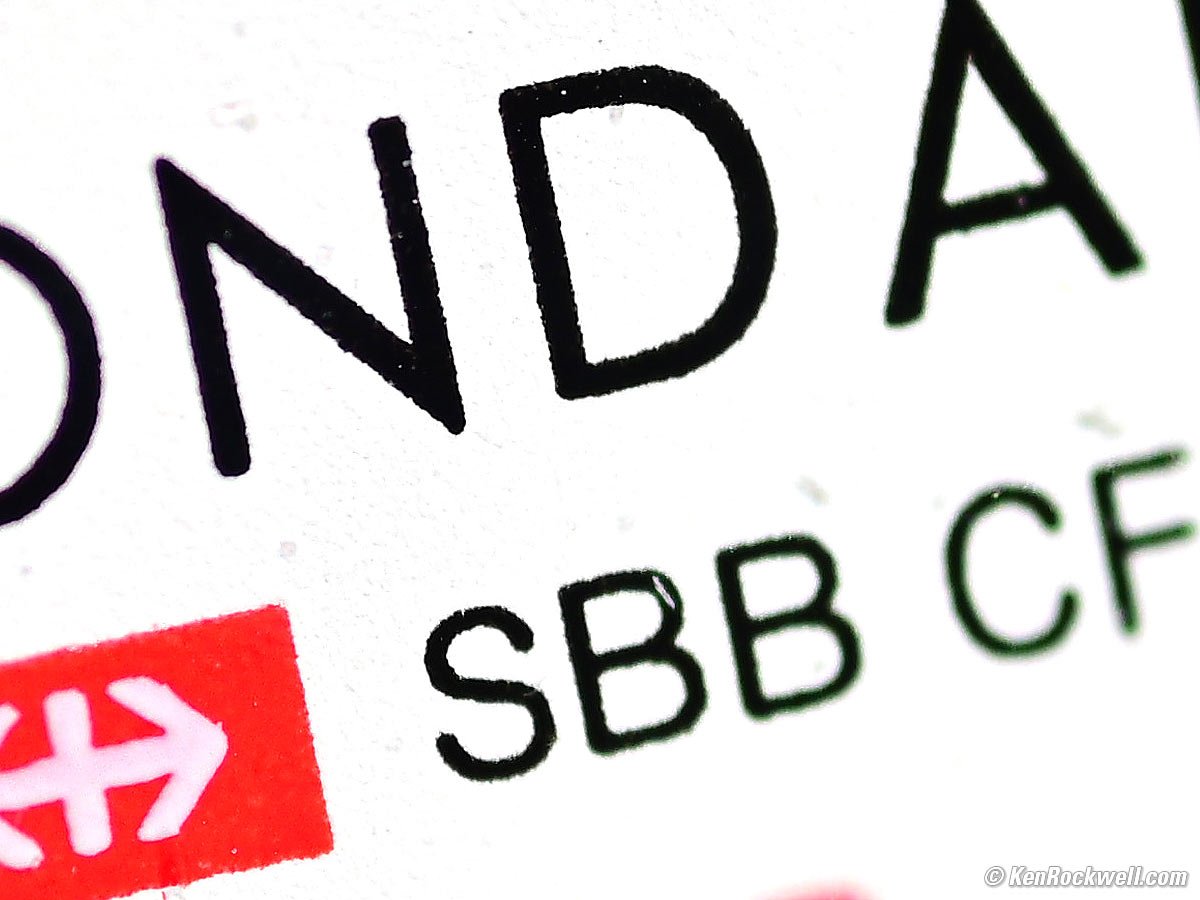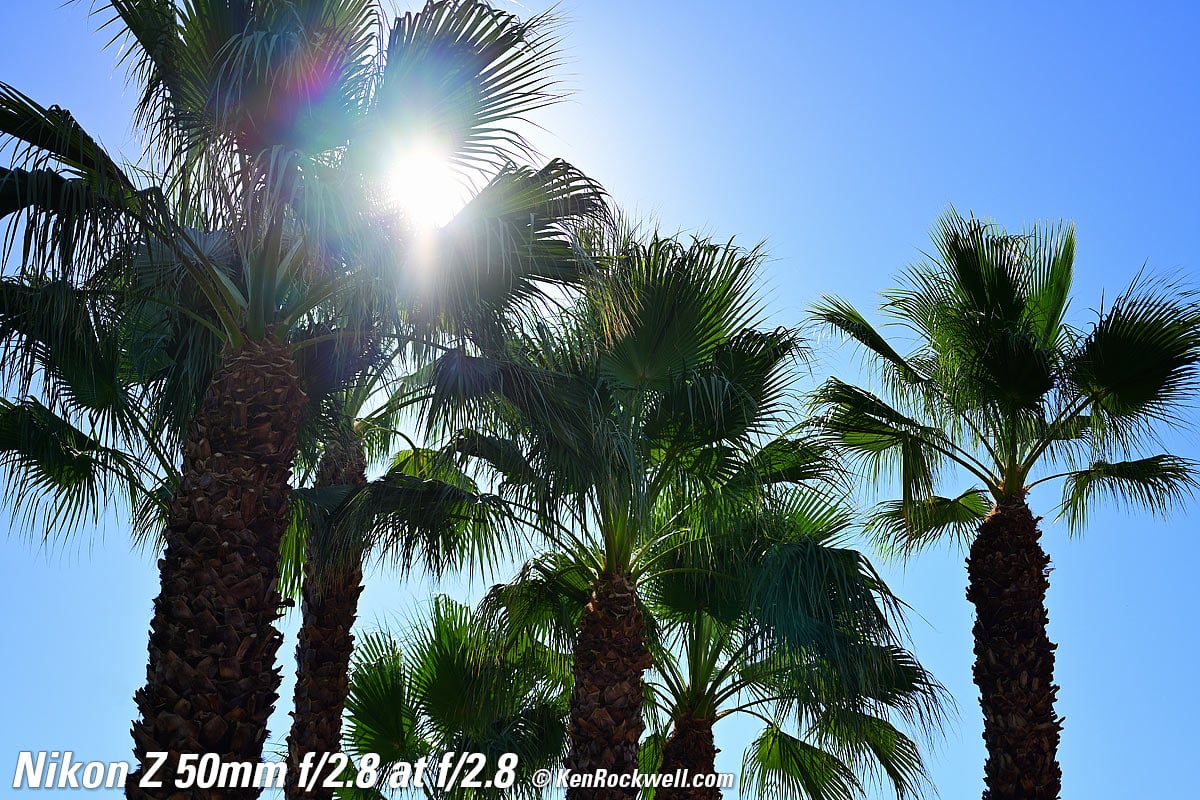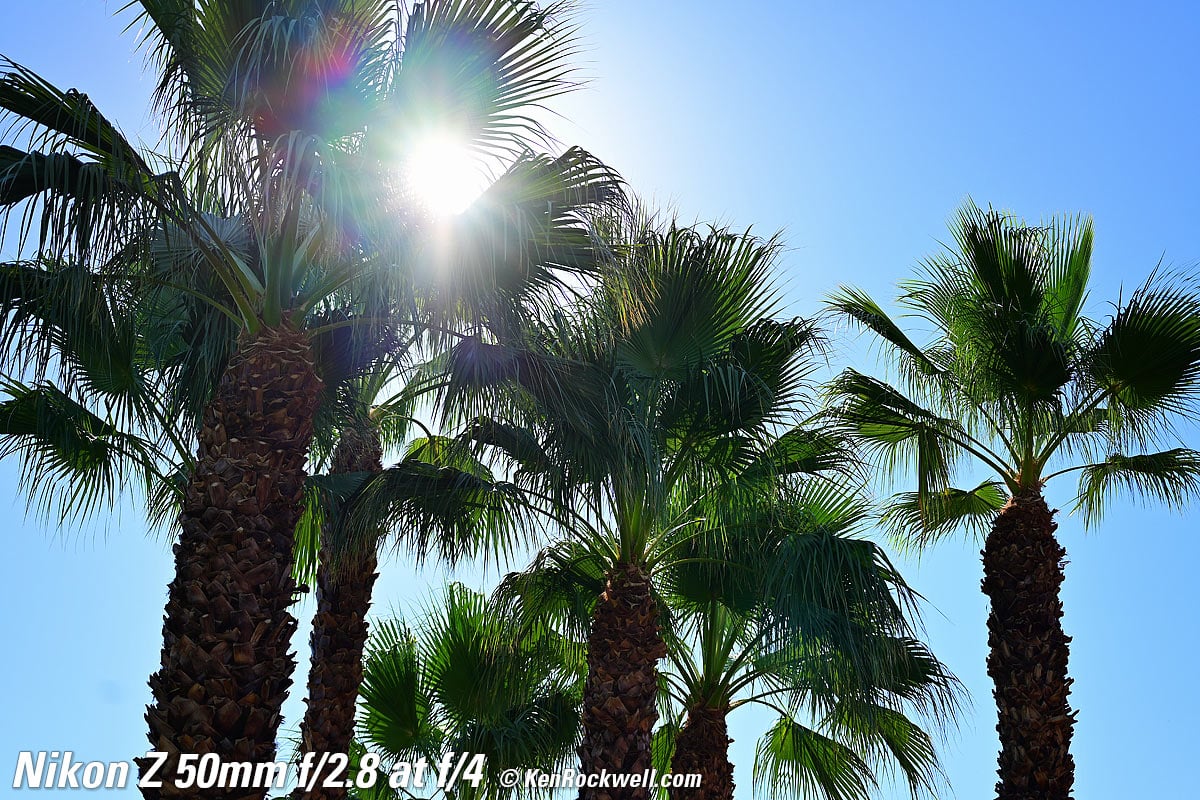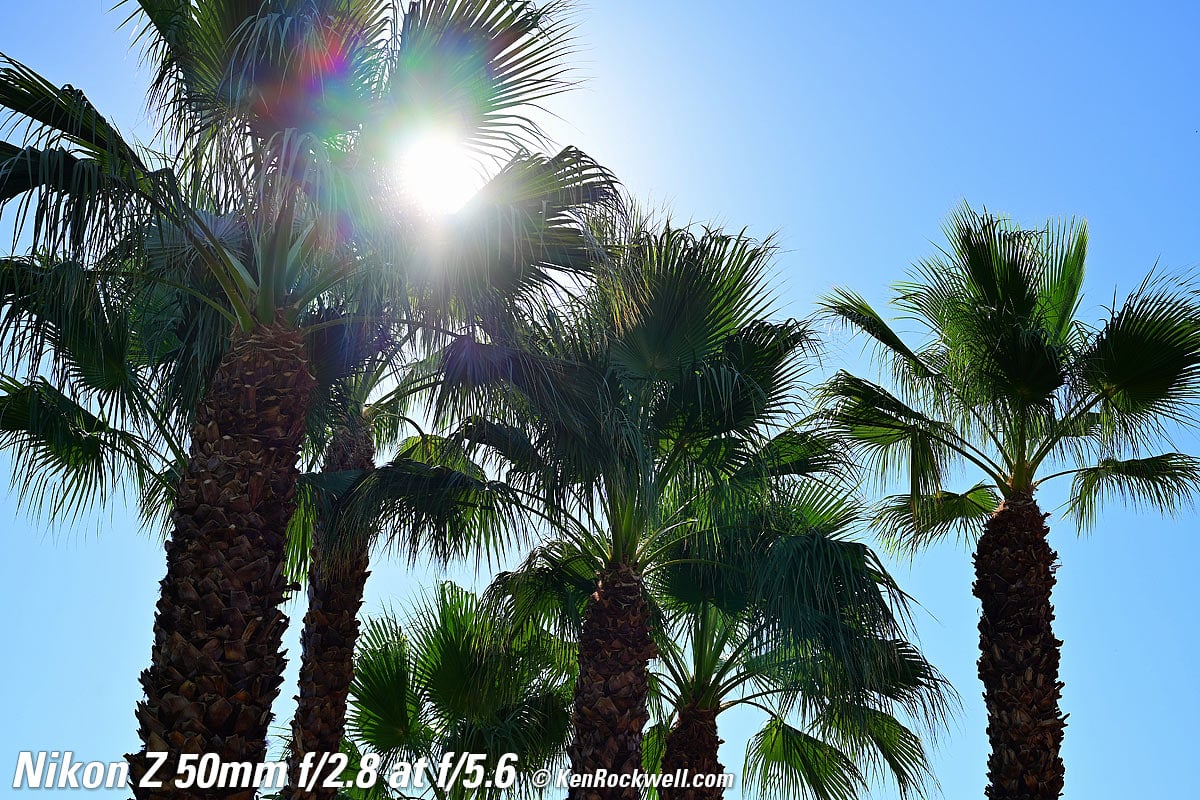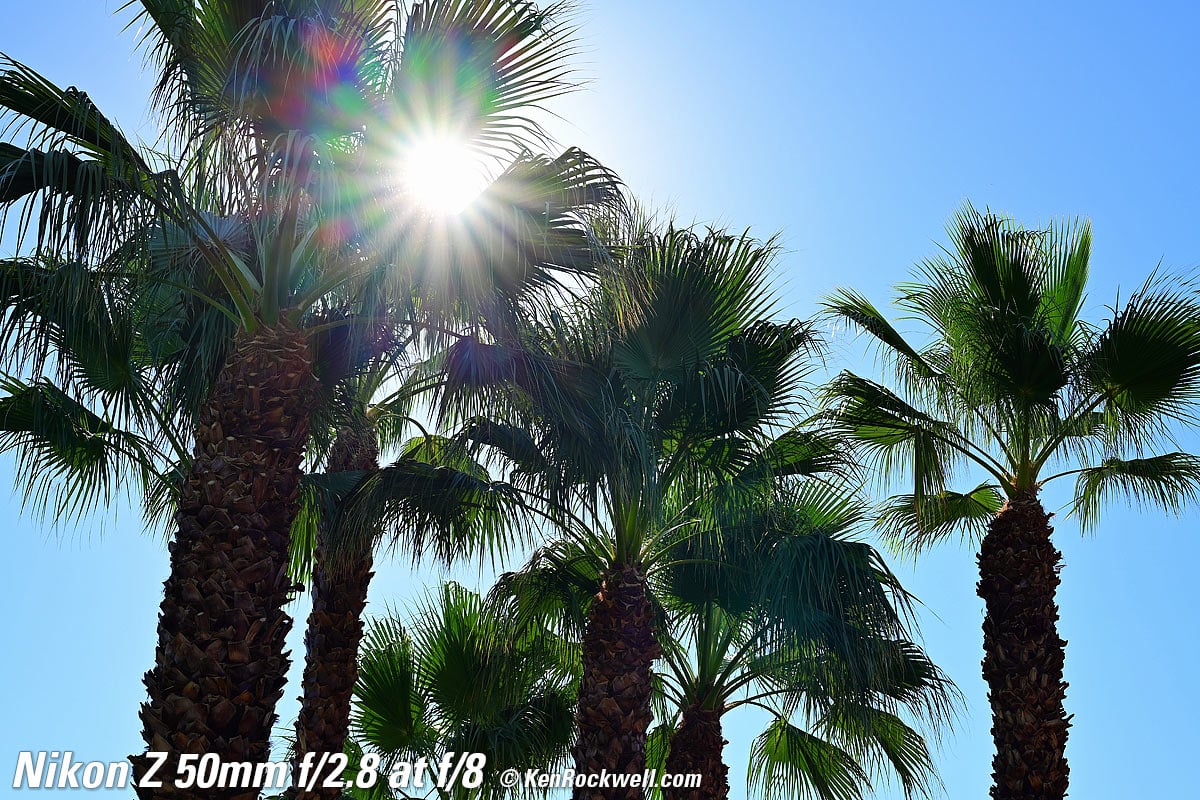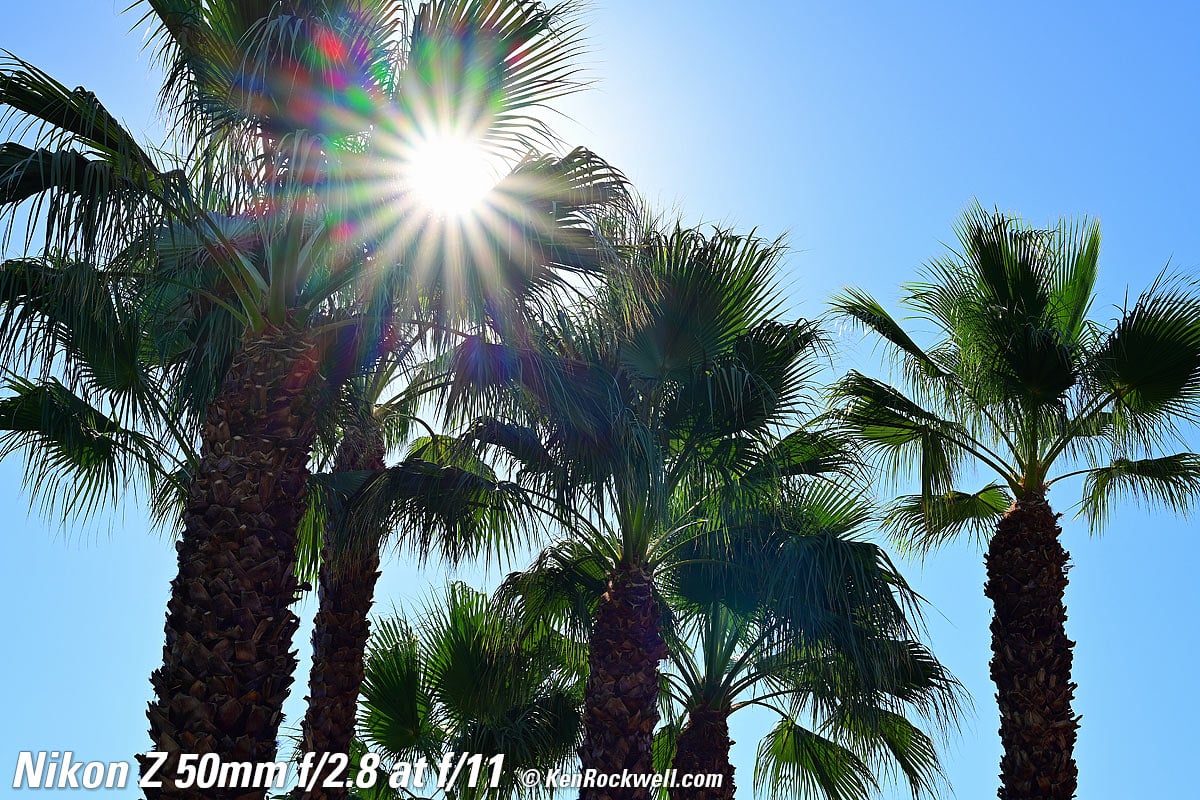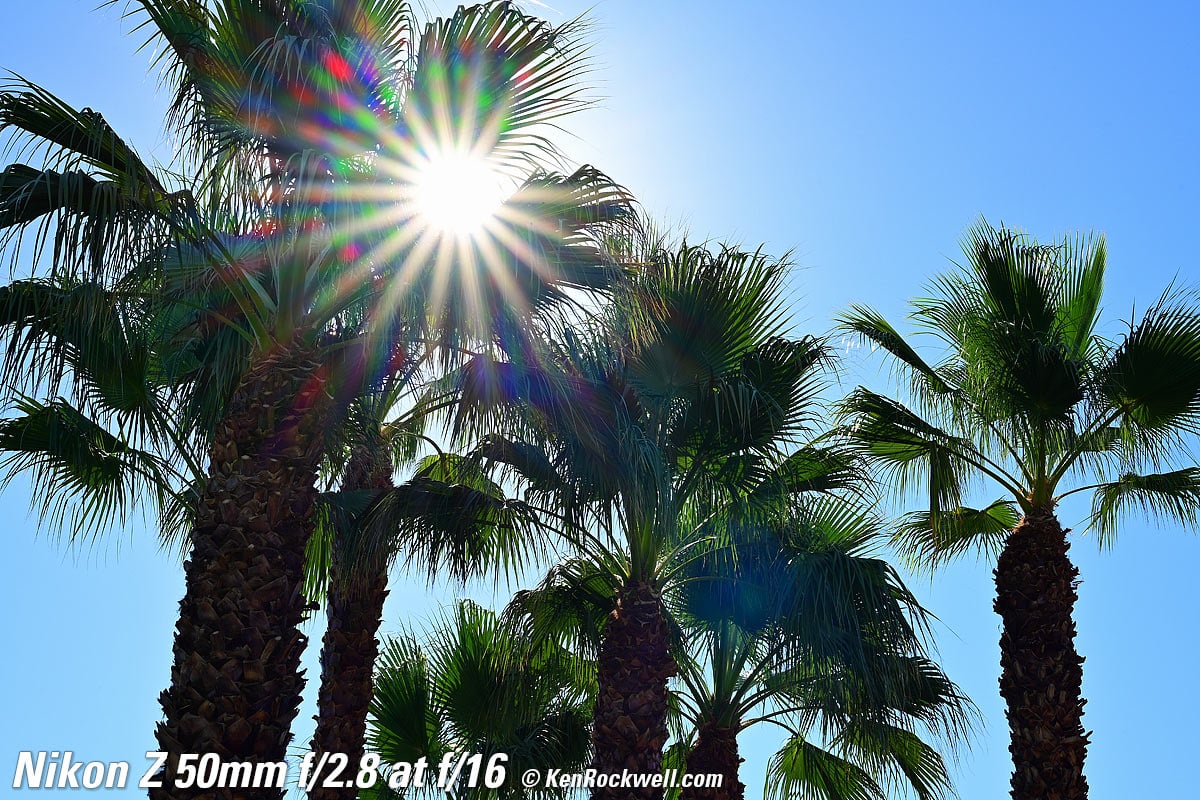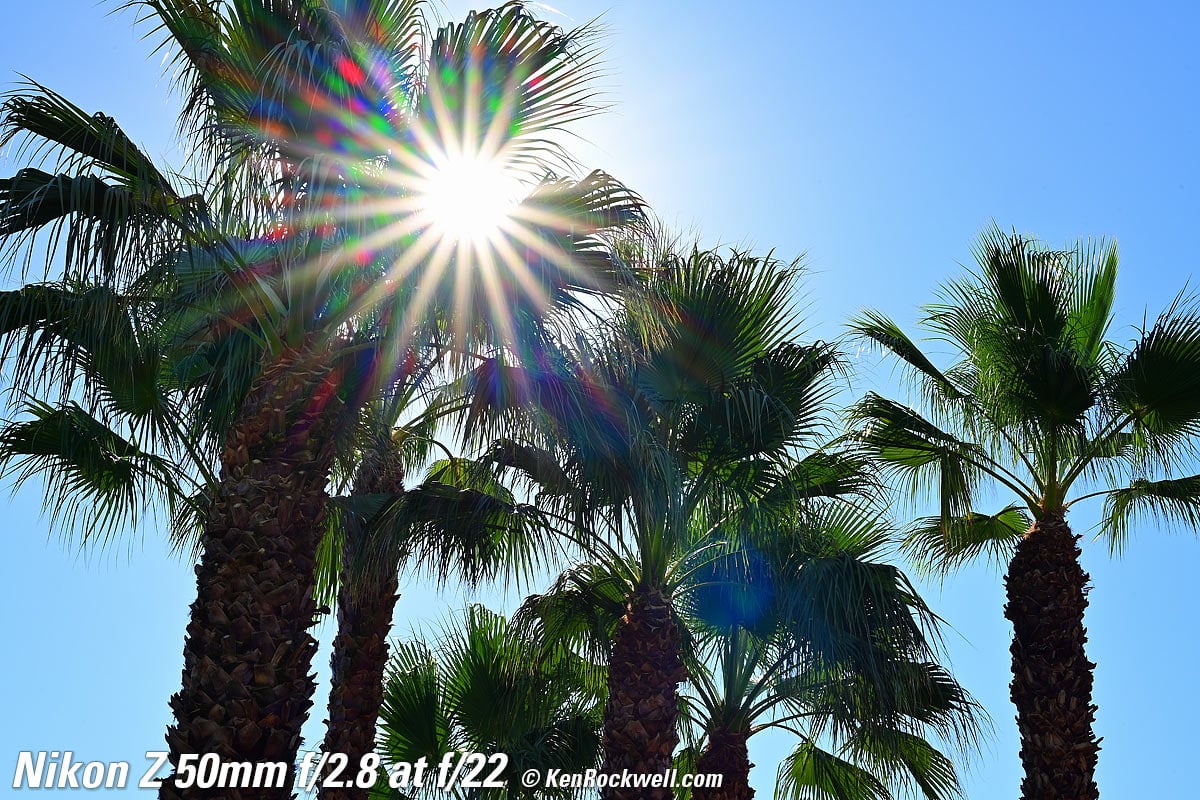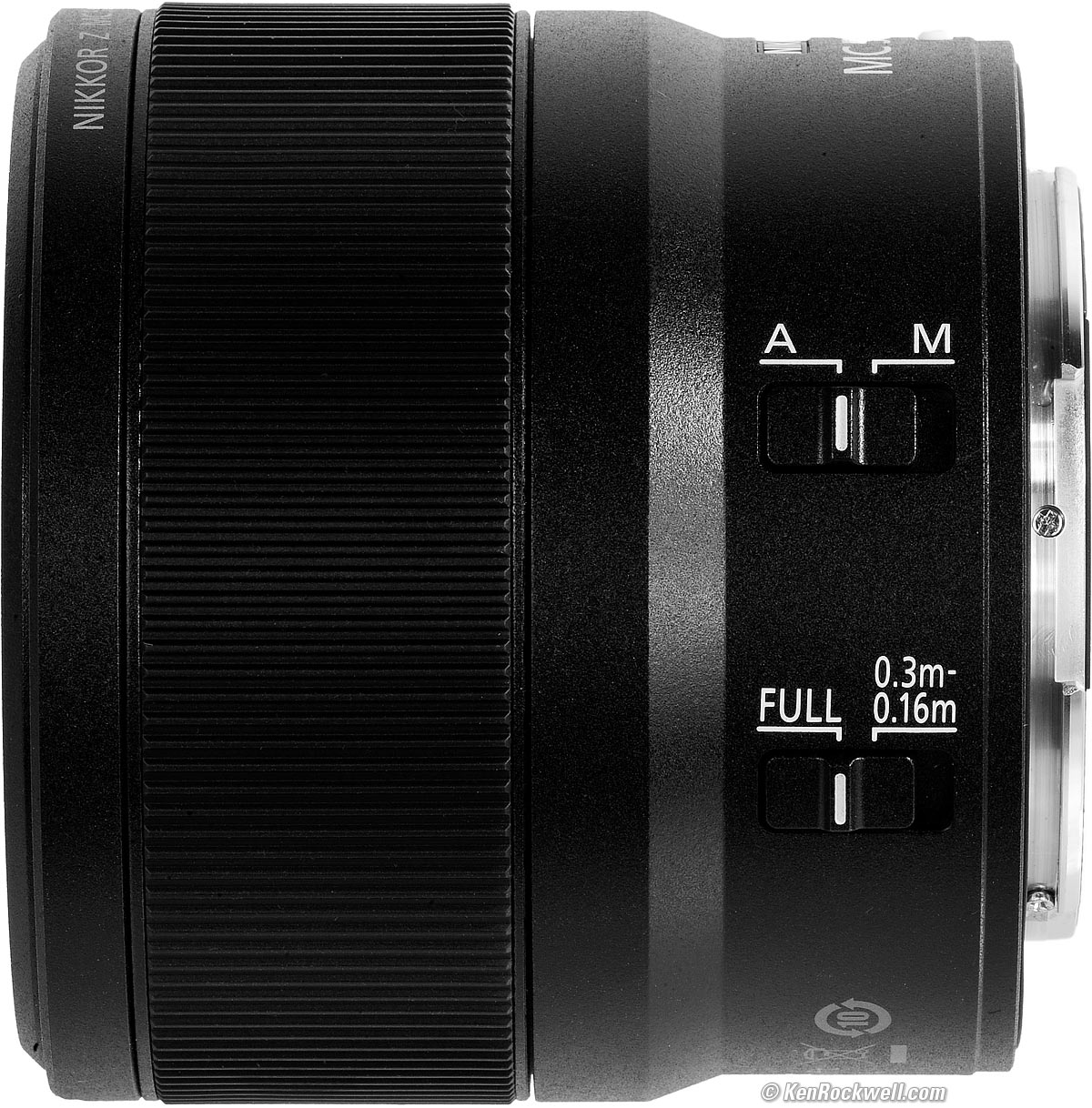Nikon Z 50mm f/2.8 Macro
Full-Frame 1:1 Macro
How to Shoot Macro Best Macro Lenses Compared
New Good Bad Missing Format Compatibility
Specifications USA Version Performance
Comparisons User's Guide Recommendations
Z9 Z8 Z7 II Z6 II Zf Z7 Z6 Z5 Z fc Z50 Z30
Z System Z Lenses All Nikon Lenses Flash
Nikon Z 50mm f/2.8 Macro (46mm filters, 9.2 oz./260g, 1:1 or 0.5'/0.16m close focus, $647). bigger. I got mine at B&H. I's also get mine at Adorama or at Crutchfield, or eventually used at eBay if you know How to Win at eBay.
This 100% all-content, junk-free website's biggest source of support is when you use those or any of these links to my personally approved sources I've used myself for way over 100 combined years when you get anything, regardless of the country in which you live — but I receive nothing for my efforts if you get it elsewhere. Nikon does not seal its boxes in any way, so never buy at retail or any other source not on my personally approved list since you'll have no way of knowing if you're missing accessories, getting a defective, damaged, returned, dropped, incomplete, gray-market, store demo or used lens — and all of my personally approved sources allow for 100% cash-back returns for at least 30 days if you don't love your new lens. I've used many of these sources since the 1970s because I can try it in my own hands and return it if I don't love it, and because they ship from secure remote warehouses where no one gets to touch your new lens before you do. Buy only from the approved sources I've used myself for decades for the best prices, service, return policies and selection.
August 2021 Better Pictures Nikon Mirrorless Mirrorless Lenses All Nikon Lenses Nikon Flash All Reviews
Why Fixed Lenses Take Better Pictures
Sample Images top
New Good Bad Missing Format Compatibility
Specifications USA Version Performance
Comparisons User's Guide Recommendations
More samples throughout this review at Bokeh, Macro, Spherochromatism and Sunstars.
These are just snapshots; my real work is in my Gallery.
These were shot as BASIC ★ JPGs; no NORMAL or FINE JPGs or RAW files were used or needed.
Wide-Open
2017 Specialized Tarmac Comp 58cm, Torch Edition with orange Presta valve caps, Shimano Dura-Ace CS-R9100 12-25T cassette, Shimano Integra FC-R8000 175mm 46-36T crankset, Shimano Dura-Ace PD-R9100 pedals and awesomely inexpensive ($14), light (24g) and strong carbon-fibre bottle cages, 11:01 AM, 17 July 2021. Nikon Z7 II, wide-open at f/2.8 at 1/2,500 at Auto ISO 64 (LV 14.9), Perfectly Clear. bigger, full-resolution or camera-original © JPG file.
As expected for a macro lens, it's ultrasharp even in the corners at f/2.8. In this case, I can read the microscopic lettering on my tire on the far left edge of the image:
1,200 × 900 pixel (6.8× magnification) crop from above. bigger or camera-original © JPG file.
Thai Restaurant Interior, 12:32 PM, 18 July 2021. Nikon Z7 II, wide-open at f/2.8 hand-held at 1/15 at ISO 64 (LV 7½), Perfectly Clear. bigger or camera-original © JPG file.
Boring photo as I waited for lunch, yes, but look at the camera-original © JPG file and you'll see extreme sharpness in the plane of focus, which is the statue in the center and along the bar to the right. The plates and stainless fixtures are behind the bar.
Pad Prik King with Tofu, 12:36 PM, 18 July 2021. Slight crop from Nikon Z7 II, wide-open at f/4.5 at about 1:2 reproduction ratio hand-held at 1/15 at ISO 200 (LV 7¼), as shot. bigger or camera-original © JPG file.
Nothing's in focus except for a little bit of the kaffir lime leaf towards the right side.
Palms and Mountains, 8:56 AM, 18 July 2021. Nikon Z7 II, wide-open at f/2.8 at 1/1,250 at Auto ISO 64 (LV 13.9), Perfectly Clear. bigger, full resolution or camera-original © JPG file.
You would never do this, but it's so sharp that even shooting wide-open in broad daylight it's ultra sharp right out to the corners, as you can see in the full-resolution file. I'm impressed; I didn't expect there to be enough depth-of-field to keep both sides in focus, but I lucked out; all the trees are sharp. Of course the distant mountains and foreground shrubbery are not in focus.
At f/5.6
2017 Specialized Tarmac Comp 58cm, Torch Edition with orange Presta valve caps, Shimano Dura-Ace CS-R9100 12-25T cassette, Shimano Integra FC-R8000 175mm 46-36T crankset, Shimano Dura-Ace PD-R9100 pedals and awesomely inexpensive ($14), light (24g) and strong carbon-fibre bottle cages, 11:01 AM, 17 July 2021. Nikon Z7 II, f/5.6 at 1/800 at Auto ISO 64, -0.3 stops exposure compensation (LV 14.9), Perfectly Clear. bigger, full-resolution or camera-original © JPG file.
It gets very slightly sharper at f/5.6; here's that same edge again:
1,200 × 900 pixel (6.8× magnification) crop from above. bigger, full-resolution file or camera-original © JPG file.
At f/6.3
Palms at Last Light, 7:28 PM, 18 July 2021. Slight crop from Nikon Z7 II at f/6.3 hand-held at 1/50 at ISO 64 (LV 11.6), Perfectly Clear. bigger, full resolution or camera-original © JPG file.
At f/8
Even at f/8 there is nothing other than a paper-thin depth-of-field, which is the case for all lenses this close:
Yellow Hibiscus, 4:31 PM, 16 July 2021. Minor crop from Nikon Z7 II, f/5.6 at 1/400 at Auto ISO 64 (LV 15.3), Perfectly Clear. bigger, full resolution or camera-original © JPG file.
At f/11
Orange Roughy, 12:25 PM, 18 July 2021. Nikon Z7 II, f/11 at 1/50 hand-held at Auto ISO 64 (LV 13.2), exactly as shot. bigger or camera-original © JPG file.
Like all 50mm lenses, even at f/11 depth of field doesn't make it all the way near and far.
Introduction top
New Good Bad Missing Format Compatibility
Specifications USA Version Performance
Comparisons User's Guide Recommendations
|
I buy only from these approved sources. I can't vouch for ads below. |
This is a small, ultralight Chinese-made general-purpose normal and macro lens. It's great if you want an ultralight and reasonably fast normal lens that also focuses extremely close.
This little lens is superb for just about every kind of shooting as your everyday normal lens, and it focuses super-close, however I avoid 50mm lenses for serious macro use because you have to get so close you block your light, weird perspective makes 3D objects look funny and you annoy living subjects. For serious macro use a 105mm, 150mm or ideally a 200mm macro.
Just turn the focus ring at any time for manual-focus override.
You can pull out the front of the lens further in manual focus mode to focus slightly larger than life-size (1.16× magnification; 31mm horizontal field covered on full-frame), but don't tell anyone I told you this. My copy of this lens just happens to do this, but it's an off-label use.
I got my Z 50mm macro at B&H. I's also get mine at Adorama or at Crutchfield, or eventually used at eBay if you know How to Win at eBay.
New intro top
 Nikon's first 50mm macro for its Z series of mirrorless cameras.
Nikon's first 50mm macro for its Z series of mirrorless cameras.
 Rated 5.8 oz. (165g), measured 5.9 oz. (168g) lighter than the AF-S 60mm f/2.8G, and the AF-S 60mm f/2.8G also needs the FTZ adapter (4.7 oz./133g) to work on Z cameras.
Rated 5.8 oz. (165g), measured 5.9 oz. (168g) lighter than the AF-S 60mm f/2.8G, and the AF-S 60mm f/2.8G also needs the FTZ adapter (4.7 oz./133g) to work on Z cameras.
Good intro top
 Ultra-sharp at every aperture, as I expect for a macro lens.
Ultra-sharp at every aperture, as I expect for a macro lens.
 Makes ultra-sharp photos as a normal lens.
Makes ultra-sharp photos as a normal lens.
 You can pull out the front of the lens further in manual focus mode to be able to focus as close as 1.16× magnification (31mm horizontal field).
You can pull out the front of the lens further in manual focus mode to be able to focus as close as 1.16× magnification (31mm horizontal field).
 Claimed dust and drip resistance.
Claimed dust and drip resistance.
 Fluorine front coating for dirt and crud resistance.
Fluorine front coating for dirt and crud resistance.
 AF-MF switch.
AF-MF switch.
 Focus Limiter.
Focus Limiter.
 "Do they really think we're this silly" "case" & toy "hood" included.
"Do they really think we're this silly" "case" & toy "hood" included.
Bad intro top
 Works great as a normal lens and tests well in the lab, however I'm not impressed with it's real-world handling or image results for actual macro use. Manual focus is too sloppy and imprecise.
Works great as a normal lens and tests well in the lab, however I'm not impressed with it's real-world handling or image results for actual macro use. Manual focus is too sloppy and imprecise.
 The stepper-motor focus system seems to lack the precision needed to get exactly the fine focus we need at f/2.8.
The stepper-motor focus system seems to lack the precision needed to get exactly the fine focus we need at f/2.8.
 Production dumped to China, not made domestically in Japan.
Production dumped to China, not made domestically in Japan.
 Feels crappy in-hand, almost all-plastic and what we'd expect from something dumped to China. This is not your father's pro Nikon 55mm macro lens which you can buy brand-new for 2/3 the price of this disposable, but pricey, plastic dog plop.
Feels crappy in-hand, almost all-plastic and what we'd expect from something dumped to China. This is not your father's pro Nikon 55mm macro lens which you can buy brand-new for 2/3 the price of this disposable, but pricey, plastic dog plop.
 Nikon insults us with a "case" that's simply an unpadded cloth bag.
Nikon insults us with a "case" that's simply an unpadded cloth bag.
 Nikon insults us again with a toy "hood" that isn't.
Nikon insults us again with a toy "hood" that isn't.
Missing intro top
 Only stops down to f/22~32; macro lenses should let us get to at least f/32~45 at any distance which is where I often shoot to try to get anything in focus.
Only stops down to f/22~32; macro lenses should let us get to at least f/32~45 at any distance which is where I often shoot to try to get anything in focus.
 Included "hood" isn't.
Included "hood" isn't.
 Included "case" isn't.
Included "case" isn't.
 No VR switch for in-camera image stabilization.
No VR switch for in-camera image stabilization.
Nikon Z 50mm f/2.8 Macro. bigger.
Format top
New Good Bad Missing Format Compatibility
Specifications USA Version Performance
Comparisons User's Guide Recommendations
I got my Z 50mm macro at B&H. I's also get mine at Adorama or at Crutchfield, or eventually used at eBay if you know How to Win at eBay.
This is a full frame FX lens, and I'm reviewing it as such.
It works great on DX cameras, too, on which you may make the usual inferences.
Compatibility top
New Good Bad Missing Format Compatibility
Specifications USA Version Performance
Comparisons User's Guide Recommendations
I got my Z 50mm macro at B&H. I's also get mine at Adorama or at Crutchfield, or eventually used at eBay if you know How to Win at eBay.
Nikon Z 50mm f/2.8 Macro on a Z7 II. bigger.
This lens works only on Nikon's Z-series mirrorless cameras.
It does not so much as even mount on or adapt to any other camera.
Specifications top
New Good Bad Missing Format Compatibility
Specifications USA Version Performance
Comparisons User's Guide Recommendations
I got my Z 50mm macro at B&H. I's also get mine at Adorama or at Crutchfield, or eventually used at eBay if you know How to Win at eBay.
Name specifications top
Nikon calls this the NIKKOR Z MC 50mm f/2.8:
NIKKOR: Nikon's brand name for all their lenses.
Z: For Nikon's mirrorless cameras.
MC: Micro-NIKKOR: Nikon macro lens.
It also has:
AF-P: Stepper (Pulse) STM autofocus motor: silent and fast.
Aspherical: Specially curved glass elements for sharper pictures.
D: Couples distance information to the 3D Matrix Meter.
E: Electronic diaphragm: silent operation
ED: Magic Extra-low Dispersion glass for reduced secondary chromatic aberration.
G: Gelded; has no aperture ring.
∅46: 46mm filter thread.
Optics specifications top
Internal Optical Construction. Aspherical and ED elements.
10 elements in 7 groups.
1 glass aspherical element.
1 ED extra-low dispersion element, which helps reduce secondary axial chromatic aberration.
The front section pumps in and out as focused while the rear elements don't move.
Nikon Super Integrated multicoating (SIC).
Fluorine coating to resist dirt and smudges.
Diaphragm specifications top
Nikon Z 50mm f/2.8 Macro. bigger.
9 rounded blades.
Electronically actuated.
Stops down to f/22~32.
Filters specifications top
Plastic 46mm filter thread.
Coverage specifications top
Full-Frame (24 × 36mm) and APS-C (16 × 24mm).
Focal Length specifications top
50 mm.
When used on DX cameras, it sees the same angle of view as a 75 mm lens sees when used on an FX or 35mm camera.
See also Crop Factor.
Angle of View specifications top
47º diagonal on FX.
31½º diagonal on DX.
Autofocus specifications top
AF-P Stepper (Pulse) STM autofocus motor: silent and fast.
It's geared such that you gently can pull or push the front section in and out manually.
The front section moves in and out as focused while the rear elements don't move.
Focus Scale specifications top
No, but three markings only for very close macro distances.
Infinity Focus Stop specifications top
No.
You have to focus somehow to get precise focus at infinity, just like at every other distance.
Depth of Field Scale specifications top
No.
Infrared Focus Index specifications top
No.
Close Focus (distance from subject to image plane) specifications top
0.525 feet (6.3" or 0.16 meters).
Trick: you can pull out the front of the lens further in manual focus mode to be able to focus as close as 1.16× magnification (31mm horizontal field).
Working Distance specifications top
Working distance is the distance from subject to the front of the lens at the closest focus distance.
It's only 2.26" (57.5mm) with this lens:
Working Distance at 1:1. bigger.
This is why 50mm lenses are poor choices for shooting at 1:1: it is very difficult to stay out of your own shadow with the lens this close. You'll see the lens shadow in the Macro and Spherochromatism sections.
It's OK for flat objects, but flat objects are best put in a scanner if they're this small.
Maximum Reproduction Ratio specifications top
1:1 (1.0 ×).
Pull out the front section with your fingers in manual-focus mode and my copy can get to 1.16× magnification, but this off-label use isn't guaranteed.
Reproduction Ratio Scale specifications top
Nikon Z 50mm f/2.8 Macro. bigger.
Yes, lines marked on extending barrel.
Image Stabilizer specifications top
None.
Caps specifications top
LC-46B 46 mm snap-on front cap, included.
LF-N1 Z-mount rear cap, included.
Hoodlet specifications top
Nikon includes a pointless HN-41 hood. It's pointless as it's too shallow to do anything, but nice is that it has a 46mm thread on the front so you can put a filter on the front. Actually it's smarter to put the filter on the lens and then the hood on the filter so the filter is shielded, too, but with a depth of about 1/4" or 5mm, this hood may safely be forgotten:
Nikon Z 50mm f/2.8 Macro with HN-41 46mm screw-in hood. bigger.
HN-41 hood, larger than actual size. bigger.
Bottom side of HN-41 Hood. bigger.
You can't use a longer hood at macro distances because the working distance is so small; you'd be in the dark.
For use at normal distances a highly effective and tough hood, which also protects the moving internal front optical assembly from damage, is to man-up and buy a 62mm HN-30 screw-in metal hood, which works great screwed into the outer 62mm threads:
Nikon Z 50mm f/2.8 Macro with HN-30 screw-in metal hood. bigger.
Simulated Case specifications top
Nikon CL-C1 Lens "Case." bigger.
Nikon claims it includes a case, but it's only a CL-C1 cloth bag.
A tube sock works better.
I love my Think Tank Retrospective bags for carrying this lens with my Z system: the Z 24-200mm, this lens and my SB-400 flash.
Size specifications top
2.93" ø maximum diameter × 2.60" extension from flange at infinity; 3.41" extension at 1:1.
74.5 mm ø maximum diameter × 66 mm extension from flange at infinity; 86.5mm extension at 1:1.
Weight specifications top
9.160 oz. (259.75 g) actual measured weight.
Rated 9.2 oz. (260 g).
Quality specifications top
Made in China:
Nikon Z 50mm f/2.8 Macro. bigger.
Announced specifications top
12:08 AM, Tuesday, 01 June 2021, NYC time.
Shipping Since specifications top
Tuesday, 29 June 2021.
Included specifications top
LC-46B 46 mm snap-on front cap, included.
LF-N1 Z-mount rear cap.
HN-41 "hood."
Nikon's Model Number specifications top
20103.
Price, U. S. A. specifications top
July 2021
$647 at B&H, at Adorama and at Crutchfield.
Nikon Z 50mm f/2.8 Macro. bigger.
Nikon Z 50mm f/2.8 Macro. bigger.
Getting a Legitimate U. S. A. Version top
New Good Bad Missing Format Compatibility
Specifications USA Version Performance
Comparisons User's Guide Recommendations
I got my Z 50mm macro at B&H. I's also get mine at Adorama or at Crutchfield, or eventually used at eBay if you know How to Win at eBay.
This section applies in the U. S. A. only.
A genuine U. S. A. version has a USA Warranty Card like this, and the serial number must match the one on the bottom of your lens, otherwise you have no warranty:
Nikon USA Warranty Card. bigger.
If you don't have this card, if the card doesn't say "VALID IN THE CONTINENTAL UNITED STATES" or the serial number on the card doesn't match the one on your lens exactly, you got ripped off with a gray market version from another country. All legitimate lenses come with printed warranty cards, even if you prefer to register online. (The serial number on the box doesn't have to match, but if it doesn't it means you bought from a shady dealer who took lenses out of boxes and then resold these used lenses as new.)
Nikon stopped offering 5-year lens warranties in 2021 in an effort to save themselves money at our expense.
Did you notice the clever nod to ancient computer technology? This is printed on tractor-fed paper with torn-off sides and dot-matrix printing of model and serial numbers! If your card lacks these side details, beware. Everyone counterfeits laser holograms, but few people have dot-matix printers floating around to fake these.
Always be sure to check your box, warranty card and serial numbers while you can still return it, or just don't buy from unapproved sources or at retail so you'll be able to have your camera serviced and get free updated firmware as needed.
This is why I never buy anyplace other than from my personally approved sources. You just can't take the chance of buying elsewhere, especially at any retail store, because non-USA versions have no warranty in the U. S. A., and you won't even be able to get firmware or service for it — even if you're willing to pay out-of-pocket for it when you need it!
Nikon U. S. A. enforces its trademarks strictly. It's unlikely, but possible that US customs won't let your lens back in the country if you bought a gray-market version in the U. S. A., carried it overseas, and try to bring it back in. (If you take the chance of buying one overseas, be sure you have a receipt to prove you bought it overseas and be prepared to pay duty on it.)
If a gray market version saves you $300 it may be worth it, but for $100 or less I wouldn't risk having no warranty or support.
Get yours from the same places I do and you won't have a problem, but if you take the risk of getting yours elsewhere, be sure to check everything while you still can return it.
Performance top
New Good Bad Missing Format Compatibility
Specifications USA Version Performance
Comparisons User's Guide Recommendations
Overall Autofocus Manual Focus Breathing
Bokeh Distortion Ergonomics Falloff Filters
Flare & Ghosts Lateral Color Fringes
Maximum & Minimum Apertures Mechanics
I got my Z 50mm macro at B&H. I's also get mine at Adorama or at Crutchfield, or eventually used at eBay if you know How to Win at eBay.
Overall performance top
The Z 50 macro feels pretty dinky because it is, but it has solid optical performance at every distance.
Don't get one expecting it to be great for super close-ups because it's difficult to get natural perspective and good light on your subject due to the very short working distance typical of all 50mm macro lenses. It's not an optical problem; it's simply less practical than longer macro lenses.
Ideally you want a 105mm or 200mm macro lens if you often shoot three-dimensional subjects up close (for better perspective rendering), or often shoot near 1:1 for anything other than slide copying.
This little lens is all about being an ultralight, reasonably fast normal lens that just happens to focus extra-close if you need it.
Autofocus performance top
Autofocus speed is moderately slow, but the good news is that it never gets stuck, gives up or has to hunt. It's not fast, but it always just hums and finds focus at any distance on the first try.
Even if the focus is set to the opposite end of the range, it figures it out and finds focus.
The AF stepper motor hums slightly as it moves.
Manual Focus performance top
Manual focusing is entirely electronic; the manual focus ring isn't connected to anything other than a digital encoder.
I'm not impressed; electronic focus systems often have slight delays between when you turn the ring and when the lens responds, and this lens is typical. While it seems OK if you're just playing with it casually, it works poorly when you're on a tripod with a magnified image and trying to set an exact manual focus.
The focus motor is not silent; you can hear a slight hum as it works.
Manual focus speed is about right; it's about the right compromise between precision and speed, but it's sort of sloppy. It seems to have different levels of sensitivity depending on what you're trying to do, so it's never as good as a real mechanical manual-focus lens like the timeless 55mm f/2.8 Micro-NIKKOR AI-s.
The stepper-motor focus system seems to lack precision; the individual steps define how precisely one can focus, and the steps seem too large to let us always get exactly the fine focus we need at f/2.8.
Just grab the electronic focus ring at any time for manual-focus override anytime the camera is awake.
Better than any other brand, even if you're in AF-C and grab the manual-focus ring, it just swaps to manual focus instantly and stays in manual focus. Other brands will try to fight you for focus if you're in continuous AF, while this lens just does what you tell it to do.
Focus Breathing performance top
Focus breathing is the image changing size as focused in and out. It's important to cinematographers that the image not breathe because it looks funny if the image changes size as focus gets pulled back and forth between actors. If the lens does this, the image "breathes" by growing and contracting slightly as the dialog goes back and forth.
The image from this lens grows a bit as focused more closely.
Bokeh performance top
Bokeh, the feel, character or quality of out-of-focus areas as opposed to how far out of focus they are, is completely neutral at large apertures and poor at small apertures. Blur circles are just circles at large apertures, while they start to have rings around them at small apertures.
Here are photos from headshot distance. f/3.2 is wide-open at this distance. Click any for the © camera-original file:
Click any for the © camera-original file.
Scarecrow Owl, 19 July 2021. Nikon Z7 II at 1/800 , 1/320, 1/80 and 1/20 at ISO 64 (LV 13⅔, 13.9, 13.9 and 13.9).
As always, if you want to throw the background as far out of focus as possible, shoot wide-open and get as close as possible.
Distortion performance top
Shot with the default of Distortion Correction ON, there is no distortion.
If you turn off in-camera correction and then go out of your way looking for it, the Nikon Z 50 Macro has an invisible amount of pincushion distortion, which corrects fully with a factor of -0.70 in Photoshop's lens correction filter.
If you shoot raw and use non-manufacturer software to process the raw data into images, that software is unlikely to be able to correct the distortion as is done in-camera as JPGs.
These aren't facts or specifications, they are the results of my research that requires hours of photography and calculations on the resulting data.
Ergonomics performance top
Nikon Z 50mm f/2.8 Macro. bigger. |
Nikon Z 50mm f/2.8 Macro. bigger. |
This is a basic lens with a big control ring. By default it's an electronic focus ring, and may be reprogrammed in your camera.
While I'm not impressed with its manual focus system, at least Nikon included focus mode and focus range switches.
Otherwise it's very straightforward
Falloff performance top
Falloff on FX is invisible with the camera's Vignette Correction set to its default of NORMAL.
I've greatly exaggerated the falloff by shooting a gray field and placing these on a gray background; it will not look this bad in actual photos of real things:
Falloff on FX at infinity, Vignette Control NORMAL:
© 2021 KenRockwell.com. All rights reserved. |
If you out of your way to turn off Vignette Control and look for falloff, you may see some at f/2.8, but in actual photography there isn't anything visible by f/4:
Falloff on FX at infinity, Vignette Control OFF
© 2021 KenRockwell.com. All rights reserved. |
Filters, use with performance top
There's no need for thin filters. I can use quite a stack of 46mm filters without vignetting, so go ahead and use your standard rotating polarizer and grad filters.
While there is a 62mm thread on the outer barrel of the lens which can be used for hoods or macro flash rigs, you can't use it for filters because the front of the lens extends as focussed more closely.
Flare & Ghosts performance top
No problem.
See examples at Sunstars.
Lateral Color Fringes performance top
There are no color fringes as shot on Nikon cameras as JPG, which by default correct for any that may be there.
if you shoot raw and then use non-manufacturer software to process that data into images then there is the possibility that there might be some, but I doubt it.
Lens Corrections performance top
The Z7 II, Z6 II, Z7, Z6, and Z5 correct for any or all of distortion, diffraction and falloff, any of which you may turn ON or OFF.
The Z7 II, Z6 II, Z7, Z6, and Z5 always correct for lateral color fringes (lateral chromatic aberration), this is part of Nikon's secret sauce and never appears in any menu.
Macro Performance performance top
Macro works great if and only if you can get your subject well-lit and perfectly aligned to the plane of focus.
Wide-Open (f/5.6 at 1:1)
It's ultrasharp wide-open, which is an effective aperture of f/5.6 at 1:1.
The depth-of-field for all macro lenses is approximately zero at these close distances wide-open. Very little is in focus and this is as straight as I could align the watch, so only some sections of the face are in focus. The rest is out of focus and not supposed to be sharp.
Casio G-Shock Solar Atomic Watch at 1:1 close-focus distance, 19 July 2021. Nikon Z7 II, f/5.6 at 1/250 at ISO 64 (LV 13.6). bigger or camera-original © file.
1,200 × 900 pixel (6.8× magnification) crop from above. bigger or camera-original © file.
If this 1,200 × 900 pixel crop is about 3" (7.5cm) wide on your screen, the complete image would print at a large 14 × 21″ (35 × 55 cm) at this same high magnification.
If this 1,200 × 900 pixel crop is about 6" (15cm) wide on your screen, the complete image would print at a huge 27½ × 41¼″ (70 × 105 cm) at this same high magnification.
If this 1,200 × 900 pixel crop is about 12" (30cm) wide on your screen, the complete image would print at a mammoth 55 × 82½″ (1.4 × 2.1 meters) at this same extremely high magnification!
Maximum & Minimum Apertures performance top
Because the Z 50 always shows the effective aperture as focused, the maximum aperture becomes smaller as focused more closely.
Back in the olden days we used to have to calculate this manually based on lens extension and reproduction ratio, while this lens correctly corrects itself.
While of course you can't get an effective aperture of f/2.8 at close distances, more important is that once you set any aperture of f/5.6 or smaller that exposure will not change as you focus at any distance. Bravo!
Distance (approx.) |
Repro Ratio |
Maximum Aperture |
Minimum Aperture |
| ∞ ~ 7' (2m) | ∞ ~ 1:100 | f/2.8 |
f/22 |
| 7' ~ 2' (2 ~ 0.6m) | 1:100 ~ 1:11 | f/3 |
f/22 |
| 2' ~ 1' (0.6 ~ 0.3m) | 1:11 ~ 1:5 | f/3.2 |
f/22 |
| 1' ~ 0.8' (0.3 ~ 0.24m) | 1:5 ~1:3.5 | f/3.3 |
f/25 |
| 0.8' ~ 0.74' (0.24 ~ 0.22m) | 1:3.5 ~ 1:3 | f/3.5 |
f/25 |
| 0.74' ~ 0.7' (0.22 ~ 0.21m) | 1:3 ~ 1:2.8 | f/3.8 |
f/25 |
| 0.7' ~ 0.68' (0.21 ~ 0.207m) | 1:2.8 ~ 1:2.5 | f/4 |
f/25 |
| 0.68' ~ 0.64' (0.207 ~ 0.195m) | 1:2.5 ~ 1:2.2 | f/4.2 |
f/25 |
| 0.63' (0.19m) | 1:2 | f/4.5 |
f/29 |
f/4.8 |
f/29 |
||
| 0.56' (0.17m) | 1:1.4 | f/5 |
f/29 |
f/5.3 |
f/32 |
||
| 0.53' (0.16m) | 1:1 | f/5.6 |
f/32 |
Mechanical Quality performance top
Nikon Z 50mm f/2.8 Macro. bigger.
This is mostly plastic inside and outside, with glass glass and what seems like an aluminum — not brass — mount.
"Hood"
Plastic.
Front Bumper
None.
Filter Threads
Plastic.
Front Barrel Exterior
Plastic.
Focus Ring
Rubber-covered plastic.
Rear Barrel Exterior
Plastic.
Slide Switches
Plastic.
Internals
Seems like almost all plastic.
Dust Gasket at Mount
Yes.
Mount
Seems like aluminum, not sturdy brass.
Markings
Just painted.
Serial Number
Nikon Z 50mm f/2.8 Macro. bigger.
Laser burnt in brown-on-black on bottom of barrel.
Identity
Printed on top front of barrel.
Also printed on top rear of barrel.
Date Code
None found.
Noises When Shaken
Moderate to strong clunking.
Made in
Made in China.
Sharpness performance top
Lens sharpness has nothing to do with picture sharpness; every lens made in the past 100 years is more than sharp enough to make super-sharp pictures if you know what you're doing. The only limitation to picture sharpness is your skill as a photographer. It's the least talented who spend the most time worrying about lens sharpness and blame crummy pictures on their equipment rather than themselves. Skilled photographers make great images with whatever camera is in their hands; I've made some of my best images of all time with an irreparably broken camera! Most pixels are thrown away before you see them, but camera makers don't want you to know that.
If you're not getting ultra-sharp pictures with this, be sure not to shoot at f/11 or smaller where all lenses are softer due to diffraction, always shoot at ISO 100 or below because cameras become softer at ISO 200 and above, be sure everything is in perfect focus, set your camera's sharpening as you want it (I set mine to the maximum) and be sure nothing is moving, either camera or subject. If you want to ensure a soft image with any lens, shoot at f/16 or smaller at ISO 1,600 or above at default sharpening in daylight of subjects at differing distances in the same image.
People worry waaaaay too much about sharpness. It's not 1968 anymore when lenses often weren't that sharp and there could be significant differences among them; today they are all pretty much equally fantastic.
This lens is ultra-sharp in the lab from corner to corner at every aperture except for diffraction which plagues all lenses at the smallest apertures, however in the field at macro distances I sometimes see less than stellar results possibly from sloppy mechanics as the lens front extends leading to some tilting of the field of best focus.
As this is a macro lens, be forewarned that nothing is ever in focus at macro distances other than a vapor thin imaginary plane that probably never intersects with your subject. The biggest problem in pro macro shooting is trying to get your subject to lay flat enough to stay in a very thin plane of focus, even at f/32.
The solid lines are the sagittal (radial) and the dotted lines are the meridional (tangential) measurements.
Nikon's MTF chart at 10 cyc/mm and 30 cyc/mm.
Spherochromatism performance top
Spherochromatism, also called secondary spherical chromatic aberration or "color bokeh," is an advanced form of spherical and chromatic aberration in a different dimension than lateral chromatic aberration. It happens mostly in fast normal and tele lenses when spherical aberration at the ends of the color spectrum are corrected differently than in the middle of the spectrum. Spherochromatism can cause colored fringes on out-of-focus highlights, usually seen as green fringes on backgrounds and magenta fringes on foregrounds. Spherochromatism is common in fast lenses of moderate focal length when shooting contrasty items at full aperture. It goes away as stopped down.
It has very little spherochromatism:
Mondaine A132.30348.11SBB at close-focus distance wide-open at f/5.6, 19 July 2021. bigger or camera-original © file.
1,200 × 900 pixel (6.8× magnification) crop from above. bigger or camera-original © file.
If this 1,200 × 900 pixel crop is about 3" (7.5cm) wide on your screen, the complete image would print at a large 14 × 21″ (35 × 55 cm) at this same high magnification.
If this 1,200 × 900 pixel crop is about 6" (15cm) wide on your screen, the complete image would print at a huge 27½ × 41¼″ (70 × 105 cm) at this same high magnification.
If this 1,200 × 900 pixel crop is about 12" (30cm) wide on your screen, the complete image would print at a mammoth 55 × 82½″ (1.4 × 2.1 meters) at this same extremely high magnification!
VR Image Stabilization performance top
This lens has no Optical Image Stabilization (OIS, IS or VR (Vibration Reduction)), but works great on a camera with internal stabilization.
"Percent Perfectly Sharp Shots" are the percentage of frames with 100% perfect tripod-equivalent sharpness I get when I'm shooting hand-held while free-standing with no support or bracing. Hand tremor is a random occurrence, so at marginal speeds some frames will be perfectly sharp while others will be in various stages of blur — all at the same shutter speed. This rates what percentage of shots are perfectly sharp, not how sharp are all the frames.
As shot on a Z7 II with it's own internal stabilization:
| % Perfectly Sharp Shots | 1 |
1/2 |
1/4 |
1/8 |
1/15 |
1/30 |
1/60 |
1/125 |
1/250 |
| Stabilization ON | 0 |
17 |
0 |
67 |
100 |
100 |
100 |
100 |
100 |
| Stabilization OFF | 0 |
0 |
0 |
0 |
0 |
0 |
28 |
100 |
100 |
I see about a 3.7 stop real-world improvement, which is pretty good. None of these systems actually meets their claimed performance when tested as I do for perfect, tripod-equivalent sharpness, so getting 3.7 stops of real world performance is good. This is on a Z7II, which has its own internal stabilization.
Sunstars performance top
With a 9-bladed rounded diaphragm, I get soft 18-pointed sunstars on brilliant points of light at medium apertures which get sharper at the smallest apertures.
Ignore the the vertical smear at large apertures, this is is a sensor artifact called interline transfer smear and not a lens defect.
Likewise ignore the crazy red, green and blue dots at small apertures; these are sensor artifacts caused by taking a picture directly of the sun and exposing for the dark underside of a huge palm tree, and using that same palm tree to hide the sky to accentuate the stars.
Click any to enlarge:
Click any to enlarge.
Compared top
New Good Bad Missing Format Compatibility
Specifications USA Version Performance
Comparisons User's Guide Recommendations
I got my Z 50mm macro at B&H. I's also get mine at Adorama or at Crutchfield, or eventually used at eBay if you know How to Win at eBay.
This is a very dinky lens. It feels cheap because it is; it's Nikon's crappiest 50mm to 60mm macro lens ever made, and Nikon's been making them since 1956. If you value light weight, so be it, but personally I'd feel much better with an AF-S 60mm f/2.8G and using it on the FTZ adapter.
If you just want a lightweight moderately fast normal lens that also focuses very close, then this is your lens, but if you're at all serious about macro, man-up for the Z 105mm f/2.8. It's only 54% more expensive but more than twice the lens.
Also look at the Irix 150mm f/2.8 Macro for serious macro use, as it has a better (longer) focal length, superior direct-mechanical manual focussing, and costs less. Use it with the FTZ adapter.
User's Guide top
New Good Bad Missing Format Compatibility
Specifications USA Version Performance
Comparisons User's Guide Recommendations
I got my Z 50mm macro at B&H. I's also get mine at Adorama or at Crutchfield, or eventually used at eBay if you know How to Win at eBay.
Nikon Z 50mm f/2.8 Macro. bigger.
A - M Switch user's guide top
A: Auto Focus. You have manual focus override by turning the focus ring at any time.
M: Manual Focus only. It effectively locks the focus so long as you don't touch the focus ring.
Full / 0.3-0.16m Switch user's guide top
This is a focus limiter.
Leave it in FULL.
The 0.3-0.16m (1 ~ 0.5 foot) position prevents the lens from autofocusing farther away than 1 foot (0.3 meters). Use this setting only if you're having a problem with the lens attempting to focus on irrelevant distant objects while shooting close-up or if for some reason the lens is "hunting" from near to far looking for distant subjects.
Ultra Macro Trick
The focus motor system is so dinky that you can pull-out the front of the lens further in manual focus mode and focus as close as 1.16× magnification (31mm horizontal field).
Vibration Reduction (VR) Switches user's guide top
None; you have to set this in a camera menu if your camera has internal stabilization.
Recommendations top
New Good Bad Missing Format Compatibility
Specifications USA Version Performance
Comparisons User's Guide Recommendations
I got my Z 50mm macro at B&H. I's also get mine at Adorama or at Crutchfield, or eventually used at eBay if you know How to Win at eBay.
If you want a lightweight moderately fast normal lens that also focuses extremely close, this is your lens, but if you're at all serious about macro, man-up for the Z 105mm f/2.8. It's only 54% more expensive but more than twice the lens, especially for macro.
If weight isn't that big a deal for you, I'd suggest with the much better-made AF-S 60mm f/2.8G (which costs less) and using it on the FTZ adapter.
If macro is important and money is tight, Nikon's manual-focus 105mm f/4 AI and 105mm f/2.8 AI-s lenses are mechanical and optical works of art, are very inexpensive used, and work great if you're on a tripod with manual focus and aperture operation on an FTZ adapter or cheap Chinese adapter. I'd much rather use one of these manual-focus lenses, or ideally the superb 105mm f/2.8 AF-D which works as a manual-focus lens on the FTZ but with full data communication on Z cameras. Any of these 105mm lenses will give much better results if you're serious about macro for anything other than slide copying. For slide copying, this 50mm lens is swell.
See also Best Macro Lenses and How to Shoot Macro.I use a clear (UV) protective filter instead of a cap so I'm always ready to shoot instantly. I only use a cap when I throw this in a bag with other gear without padding — which is never. The UV filter never gets in the way, and never gets lost, either.
Use the excellent and inexpensive water-resistant multicoated Hoya NXT+ 46mm UV, multicoated B+W 010M, plain B+W 46mm 010, or any multicoated Hoya filter.
If you want a fancy filter, go for the LEICA 13033 E46 UVa II in black, the LEICA 13034 E46 UVa II in silver or the Fujifilm PRF-46 Protector Filter.
All these filters are just as sharp and take the same pictures, the difference is how much abuse they'll take and stay clean and stay in one piece. Since filters last a lifetime or more, there's no reason not to buy the best as it will last you for the next 40 years; I'd get the water-resistant multicoated Hoya NXT+ 46mm UV. Filters aren't throwaways like digital cameras which we replace every few years, like it or not. I'm still using filters I bought back in the 1970s!
I got my Z 50mm macro at B&H. I's also get mine at Adorama or at Crutchfield, or eventually used at eBay if you know How to Win at eBay.This 100% all-content, junk-free website's biggest source of support is when you use those or any of these links to my personally approved sources I've used myself for way over 100 combined years when you get anything, regardless of the country in which you live — but I receive nothing for my efforts if you get it elsewhere. Nikon does not seal its boxes in any way, so never buy at retail or any other source not on my personally approved list since you'll have no way of knowing if you're missing accessories, getting a defective, damaged, returned, dropped, incomplete, gray-market, store demo or used lens — and all of my personally approved sources allow for 100% cash-back returns for at least 30 days if you don't love your new lens. I've used many of these sources since the 1970s because I can try it in my own hands and return it if I don't love it, and because they ship from secure remote warehouses where no one gets to touch your new lens before you do. Buy only from the approved sources I've used myself for decades for the best prices, service, return policies and selection.
Thanks for helping me help you!
Ken.
© Ken Rockwell. All rights reserved. Tous droits réservés. Alle Rechte vorbehalten. Ken Rockwell® is a registered trademark.
Help Me Help You top
I support my growing family through this website, as crazy as it might seem.
The biggest help is when you use any of these links when you get anything. It costs you nothing, and is this site's, and thus my family's, biggest source of support. These places always have the best prices and service, which is why I've used them since before this website existed. I recommend them all personally.
If you find this page as helpful as a book you might have had to buy or a workshop you may have had to take, feel free to help me continue helping everyone.
If you've gotten your gear through one of my links or helped otherwise, you're family. It's great people like you who allow me to keep adding to this site full-time. Thanks!
If you haven't helped yet, please do, and consider helping me with a gift of $5.00.
As this page is copyrighted and formally registered, it is unlawful to make copies, especially in the form of printouts for personal use. If you wish to make a printout for personal use, you are granted one-time permission only if you PayPal me $5.00 per printout or part thereof. Thank you!
Thanks for reading!
Ken.
